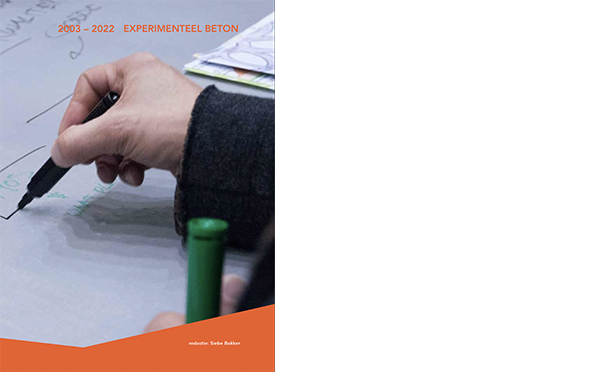
Experimenteel Beton 2003 - 2022
2023 / Dutch
Overview of 20 years Experimenteel Beton
editor
Siebe Bakker
graphic design: Siebe Bakker & Fatih Cebeci
Backflap (NL)
EXPERIMENTEEL BETON beoogt een inspirerende uitwisseling van ideeën, ambities en expertises tussen ontwerpers en producenten. Overtuigd van de innovatieve kracht van samenwerking is het noodzakelijk om deze vorm te geven, te initiëren, te koesteren, en te laten zien.
Ieder wordt aangesproken op hun eigen kracht en kennis. Ontwerpers, producenten en experts. Het doel is om elkaar te leren kennen, elkaars ambities, elkaars uitdagingen. Alleen
wanneer men gedegen inzicht heeft in de wereld van de ander kan een vruchtbare dialoog ontstaan. Het doel is om de randen van het mogelijke met beton op te zoeken,elkaar uit te dagen, er overheen te gaan, en mogelijk nieuwe toepassingen en technieken te verkennen.
EXPERIMENTEEL BETON gaat verder dan het uitwisselen en ontwikkelen van ideeën en plannen. Ze worden daadwerkelijk uitgevoerd, getest en gewogen. De resultaten van de
intensieve samenwerking worden tastbaar en vormen de kiem voor verbazing, debat en vervolg.
Deze publicatie toont 129 prototypen, die de afgelopen 20 jaar in 16 sessies zijn ontwikkeld door meer dan 150 ontwerpers, samen met een kleine 100 producenten en experts.
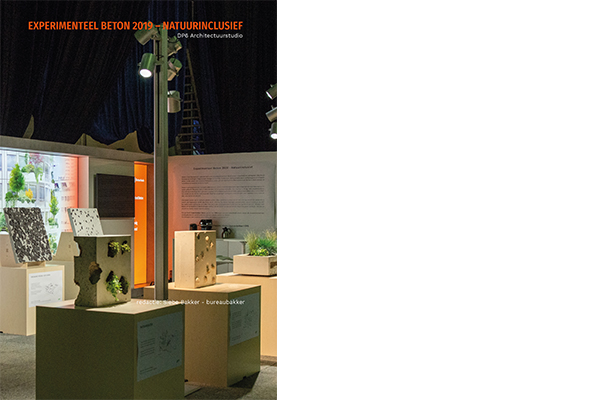
Experimenteel Beton 2019 Nature Inclusive
2020 / Dutch
Results from the Experimenteel Beton 'Nature Inclusive' cycle with DP6.
editor
Siebe Bakker
graphic design: Siebe Bakker
Natuurinclusief (NL)
Beton is een fascinerend materiaal. Het is een bouwmateriaal waar we de wereld mee maken en vormgeven. Met beton bouwen we woningen, flatgebouwen, bruggen en tunnels. In elke vorm, stevig en sterk, maar ook homogeen en integraal. Beton is niet alleen een constructiemateriaal, maar ook een fascinerend afbouwmateriaal. Beton is dimensieloos en schaalbaar en verbindt macro- en microniveau.
Beton is samengesteld met het bindmiddel cement. Cement heeft de bijzondere eigenschap dat het door toevoeging van water verhardt. We gieten het in mallen en laten het simpelweg verharden. Het resultaat is stevig, hard, onverwoestbaar. Bijna als tovenarij. Maar zit er ook leven in beton?
DP6 architectuurstudio uit Delft is gefascineerd door natuurinclusiviteit. Een maakbare wereld die leeft en groeit. Waar het aangenaam verblijven is met een plek voor iedereen. Voor mens en dier, voor bomen en planten.
Met beton kunnen we fantastische plekken maken. Maar daarmee bouwen we aan een stenige wereld die opwarmt en waarin ons regenwater wordt afgevoerd via de riolering. Kan beton bijdragen aan een meer natuurinclusieve wereld? Kan beton water vasthouden als buffer? Kan beton een voedingsbodem bieden voor een groenere wereld? Of een betere plek bieden om te nestelen of beschutting te zoeken? Als een groen tuintje aan je huis, waar alles groeit en bloeit. Dat zou de wereld een beetje mooier kunnen maken!
Dit jaar heeft Experimenteel Beton samen met DP6 acht samples ontwikkeld
waarin beton als bouwmateriaal een voedingsbodem en verblijfsplek kan zijn
voor dieren, bomen en planten.
De uitkomst is een creatieve verzameling van ‘Natuurinclusief Beton’.
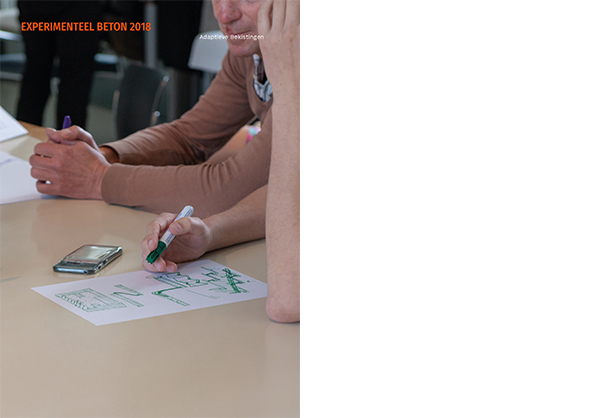
Experimenteel Beton 2018
2019 / Dutch
Results from the Experimenteel Beton 'Adaptive Formwork' and 'Allcrete' cycles.
editor
Siebe Bakker
graphic design: Siebe Bakker
Adaptieve Bekistingen (NL)
Traditioneel worden prefab betonelementen gezien als een snelle, economische, maar vaak ook saaie wijze van bouwen. Het produceren van de elementen onder ideale omstandigheden in een fabriek leidt zondermeer tot optimale kwaliteit, zowel technisch als esthetisch, maar toch lijkt het dat tijdens ontwerpprocessen dit niet opweegt tegen de ‘vrijheid’ van de ontwerpers om unieke, architectonisch interessante gebouwen te maken.
Momenteel wordt groots ingezet op moderne computergestuurde ontwerp- en productietechnieken die voor veel disciplines openingen bieden om zowel fabrieksmatig – gecontroleerd en continue – te produceren, als wel om elke eenheid (element) een eigen vormgeving, technische specificatie of functie mee te geven. Ook in de bouw wordt uitgekeken naar economische oplossingen voor variatie en complexe vormen. Voor de betonindustrie betekent dit vooralsnog het moeten inzetten van tijdrovende en dure oplossingen voor het vervaardigen van de bekistingen.
Houten constructies, waarbij men kan stellen dat een groot deel van het vakmanschap door de timmerfabriek wordt geleverd, of het CnC frezen van mallen uit kunststoffen, waarbij met name de ecologische factoren een belangrijke rol gaan spelen. 3D-printen met beton is een onderzoeksterrein waar veel aandacht naar uitgaat, veelbelovend, maar er zullen nog cruciale stappen gezet moeten worden ten aanzien van de constructieve karakteristieken, de esthetische resultaten en de te gebruiken mengsels zelf.
EXPERIMENTEEL BETON 2018 zal bekistingstechnieken en -mogelijkheden verkennen. Waarbij enerzijds de kwalitatieve en kwantitatieve voordelen van het produceren in een fabriek worden benut, en anderzijds met inzet van nieuwe technieken en intelligente oplossingen en ontwerpen, het palet aan vorm en textuuropties wordt verbreed.
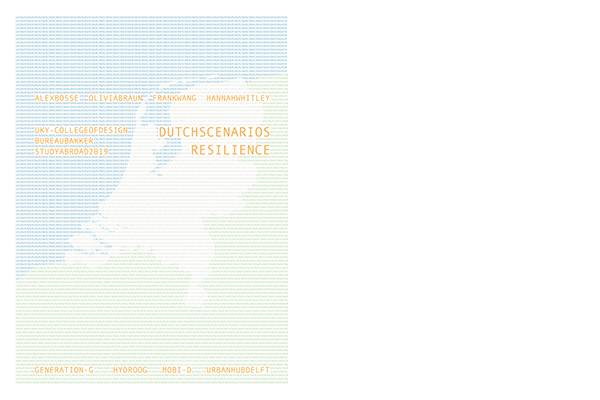
Dutch Scenarios Resilience
2018 / English
Results from the Dutch Scenarios Resilience 'Design Thinking' studio for students of the University of Kentucky - College of Design. The studio explored plausible scenarios for the municipality of Delft, reflecting on its future position within the Metropole Region Rotterdam Den Haag. Four scenarios are presented. Contributions by Alex Bosse, Olivia Braun, Hannah Whitley & Frank Wang.
editor
Siebe Bakker
graphic design: Siebe Bakker, Alex Bosse, Olivia Braun, Hannah Whitley & Frank Wang
Backflap (EN)
Cities and regions all over the world are reinventing their positions; either driven by changes in national policies decentralizing governance or reacting to the reality of competition and collaboration on subjects such as economy, services or the changing number of inhabitants. This often originates from a desire or perceived necessity to respond to the changing ambitions of industries and citizens, as well as to global influences.
Due to the complex and intricate nature of upcoming challenges, there’s a need to improve decision-making and policy processes just as much as there’s a need to service and renew spatial structures as demands are changing. One can state that changes in urban developments are driven by changes in population and their needs. Energy and sustainability issues have become a common consciousness deserving appropriate response in terms of policy and spatial planning. One can easily add to these examples.
DESIGN THINKING
These current challenges are becoming more complex and interwoven. Fed by a large number of sometimes contradictory and various ambitions they need to be addressed in a manner that justifies all involved. Changes are good. And by nature, changes are complex and difficult to implement. They are disruptive and evoke resistance. Change needs community, involvement, and commitment. The more complex a challenge is, the more actors or stakeholders need to be involved, and the more inadequate traditional means to development becomes.
One needs to build robust solutions, or better, robust environments and contexts. Solutions tend to address current situations incapable of adjusting to changing realities. It is exactly those rapidly changing realities – economical, political and social – that have led to the realization that innovation in governance and policymaking processes is crucial for a city to keep operating successfully. Intelligent ways to address and implement developments are needed. Intelligent in terms of creating efficient and economically viable solutions for both processes and implementations; intelligent as in being informed by relevant parties. And the design practice, in general, is by nature the discipline to tackle complex challenges.
STUDIO
Dutch Scenarios – RESILIENCE is a case study based research & design program. Students from the University of Kentucky took on the challenge to research global and national trend and ambitions related to creating resilient conditions. The city of Delft was taken as the object of projection and testing through developing potential interventions for the municipality of Delft. Current ambitions and trends involve the position of the city of Delft in the upcoming Region Metropole Rotterdam The Hague, the relation between the Delft University of Technology and the city itself and generic European and global challenges.
We did research the current condition of Delft concerning the region and in comparison to similar cities in Europe and the US. The main focus for the development of various scenarios was to enhance opportunities and ambitions and with a special interest to the built environment.
Although the subject of research is realistic and based on actual ambitions and challenges the Dutch Scenarios studio produced ‘academic’ results. It is not our aim to provide ‘ready- to-use’ solutions for either the municipality of Delft or other stakeholders. Our results need to be based on an open and suggestive approach and can be as extreme in terms of content and implementation conditions (financially / political / etc.) as the research and development of scenarios dictate. As much as the developed scenarios and proposed (spatial) implementations are grounded in actual conditions and political, economic or cultural ambitions they are meant to question and unveil exactly those premises.
The studio has been run as a design office. We worked as a team, producing results both individually and as a group. Our studio is located within a collective office with professional interior designers, architects, and artists. In principal worked five days a week for an eight week period during which we also visited sites, exhibitions, and lectures in the Netherlands and abroad.
Participants gained skills in managing complex and wide-ranging design related needs and ambitions, through developing inventories, (comparative) analyses and finally extreme scenarios that unveil otherwise hidden potential. As these processes depend heavily on communication, the development of information design (of infographic design) was an integral part of this studio.
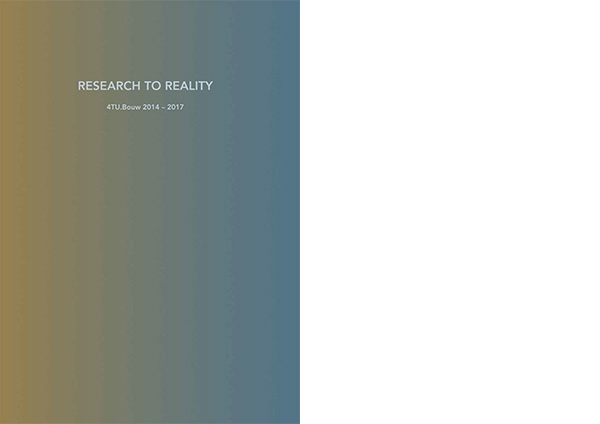
Research to Reality – 4TU.Bouw 2014 - 2017
2018 / English, Dutch
Presenting an overview of the four-year period from 2014 to 2017 of 4TU.Bouw. Around 350 researchers and students from the facultieds affiliated with 4TU.Bouw, worked with at least 300 experts from other facultiesd, industries, market parties and governments on a range of collaborative research projects, match-making events, and investigative workshops and conferences. Four years of 4TU.Bouw, led by Scientific Director Ulrich Knaack
editor
Siebe Bakker
graphic design: Siebe Bakker & Soscha Monteiro
Introduction (EN)
Most of the more persistent man-made structural assets that surround us in everyday life as well as their reliable structural services are normally taken ‘as a law of nature’ by the general public. Compared to consumer products the service levels of structural assets are extremely high. Bridges with a structural failure rate comparable to that of normal office printers would be considered completely unacceptable, while a tunnel would never be built if they had a service life expectancy comparable to the most long-lasting functional products such as (certain) washing machines or Hi-Fi-systems. The same holds for all built structures, including houses, public and commercial buildings.
Meanwhile, these structural assets together exceed in financial terms the balance of any global financial institution or the yearly budget of e.g. the Dutch government many times. Thus, the importance and impact of the broad field of science and engineering related to the built environment - which includes architecture, architectural engineering, civil engineering, process management, and policy - is not be underestimated, both economically and socially.
Notwithstanding the evident importance of the Built Environment sector, the public perception of this sector is not that positive, a trend that has been developing in the past few decades. The public perception of the sector often leans towards non-innovative, somewhat clumsy, disorganised and conservative.
It is often forgotten that inventions and innovations from any field of science and engineering are finally applied in the context of the built environment. Developments with respect to e.g. energy comfort, new building materials, and systems are spectacular. For instance, no other innovation has increased the life expectancy of people as much as the broad application of developments in sanitary engineering. It is even so, that the difference between developed an developing countries can be largely attributed to the quality of public sanitation systems. Apparently, the development of an adequate and efficient sanitation system requires the effective collaboration within the so-called ‘Golden Triangle’, i.e. stable and facilitating governments, trained people and innovation originating from educational and scientific institutions and energetic application by these innovations by the market.
Moreover, the environmental impact of the ‘building sector’ is huge, given the enormous usage of raw materials. Together with the energy sector, the building sector is at the forefront of addressing great societal challenges related to sustainability, scarcity, and availability of raw materials as well as the transition towards a circular economic model, based on recycling and upcycling of waste materials and structures.
Another development is the need for true multidisciplinary and cross-disciplinary collaboration on these challenges. Almost every field of science and engineering has found its application in the built environment. Developments within quantum mechanics have led to diverse developments like energy efficient lighting (LED), precise positioning and cutting (laser technologies) and of course to the revolutionary introduction of ICT in the built environment. Developments in (micro-) biology have led to the aforementioned sanitation revolution, whereas new insights into the mathematics of planning and operations research allowed building processes at scales that would have never been possible before.
An effective and multidisciplinary approach faces grand challenges ahead, requiring dedication and collaboration. Therefore, the four technical universities decided to collaborate – amongst others – as 4TU.Bouw Center of Excellence for the Built Environment. The 4TU.Bouw Center of Excellence consists of the faculties of Architecture and Civil Engineering and Geosciences at Delft University of Technology, the Department of the Built Environment at Eindhoven University of Technology, the faculty of Engineering Technology at Twente University and Wageningen University & Research. The overall goal of this 4TU initiative is to promote close collaboration between Dutch universities in order to increase competitiveness in international research and education and to concentrate research and education efforts to improve efficiency and scientific excellence.
Led by scientific director Ulrich Knaack during a four-year period from 2014 till 2017, 4TU.Bouw focused on activating and developing the abovementioned collaborative ambitions. Specifically, by means of three programs, supported with a communication strategy directed towards a broader audience than the academic world alone. The Lighthouse Project initiative that actively pursued imaginary research proposals following a funding setup that resembled an ‘angel capital’ approach; reasonable ‘easy’ money for intensive and short-term ‘proof of concept’ or ‘proof of failure’ proposals. Not all had to succeed in a traditional way, which was made up by the number of projects and their ambitious goals. Secondly, 4TU.Bouw supported the dedicated PDEng-training program contributing to the future availability of well-trained specialists while bridging the gap between academia and the market. Lastly, there were various collaborations with other knowledge institutes and market branch organisations to collectively inform politicians and policy decisionmakers on the relevance and urgency of built environment research and education in order effectively face the nation-wide social and cultural challenges lying ahead.
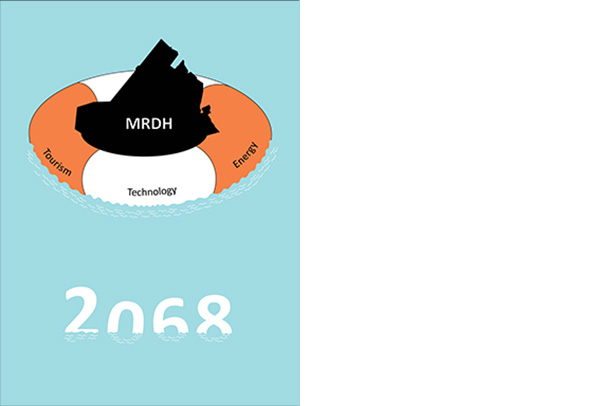
Delft Scenarios 6 – MRDH 2068
2018 / English
Results from the Delft Scenarios 06 'Design Thinking' studio for students of the University of Kentucky - College of Design. The studio explored plausible scenarios for the municipality of Delft, reflecting on its future position within the Metropole Region Rotterdam Den Haag. Three scenarios are presented. Contributions by Tyler Ryan, Rachel Crosslin & Abbie Winfield.
editor
Siebe Bakker
graphic design: Siebe Bakker, Tyler Ryan, Rachel Crosslin & Abbie Winfield
Backflap (EN)
Design Thinking
Cities all over the world are reinventing their positions, either driven by changes in national policies decentralizing governance or reacting to the reality of competition and collaboration on subjects such as economy, services or the changing number of inhabitants. Often this is generated out of a desire or perceived necessity to respond to the changing ambitions of industries and citizens. One only has to think of notions like ‘Creative Cities’, ‘Metropolitan Regions’, ‘City Branding’ and ‘Self-regulation’ to understand that traditional ways to organize one’s community will fail to adequately address these emerging ambitions.
There is a need to improve decision-making and policy processes just as much as there is a need to service and renew spatial structures as demands are changing. One can state that changes in urban developments are driven by changes in population and their needs. Energy and sustainability issues have become a common consciousness deserving appropriate response in terms of policy and spatial planning. One can easily add to these examples.
These current challenges are becoming more complex and interwoven. Fed by a large number of sometimes contradictory and definitely various ambitions, they need to be addressed in a manner that justifies all involved. Changes are good. And by nature, changes are complex and difficult to implement. They are disruptive and evoke resistance. Change needs community, involvement, and commitment. The more complex a challenge is, the more actors or stakeholders need to be involved, and the more inadequate traditional means for development becomes.
One needs to build robust solutions, or better, robust environments and contexts. Solutions tend to address current situations incapable of adjusting to changing realities. It is exactly those rapidly changing realities – economic, political and social – that have led to the realization that innovation in governance and policymaking processes is crucial for a city to keep operating successfully. Intelligent ways to address and implement developments are needed. Intelligent in terms of creating efficient and economically viable solutions for both processes and implementations; intelligent as in being informed by relevant parties.
Current notions on ‘Design Thinking’ move towards inclusive and collaborative processes. These are aimed at efficiently producing inventories and analyses of stakeholders and context. Organizing effective prototyping presents essentially different strategic options and scenarios. Finally, and foremost, these processes create collaborative structures for professionals, administrators and citizens.
Studio
MRDH 2068 is a case study based research & design program. Students from the University of Kentucky – College of Design took on the challenge to research potential interventions for the municipality of Delft. Current global, national and regional ambitions and trends involve the position of the city of Delft in the upcoming Region Metropole Rotterdam The Hague (MRDH), the relation between the Delft University of Technology and the city itself and generic European challenges as changes in demographics, economy and resilience topics like environmental and social developments.
The research includes the current state of Delft in relation to the region and comparisons to similar cities in Europe and the US. Main focus for the development of various extreme scenarios is to enhance opportunities and ambitions with a special interest to the built environment.
Although the subject of research is realistic and based on actual ambitions, challenges and facts, the MRDH 2068 studio produces ‘academic’ results. It is not our aim to provide ‘ready-to-use’ solutions for either the municipality of Delft or other stakeholders. Our results are based on an open and suggestive approach and can be as extreme in terms of content and implication conditions (financial, political, etc.) as the research and development of scenarios dictate. As much as the developed scenarios and proposed (spatial) implementations are grounded in actual conditions and political, economic or cultural ambitions they are meant to question and unveil exactly those premises.
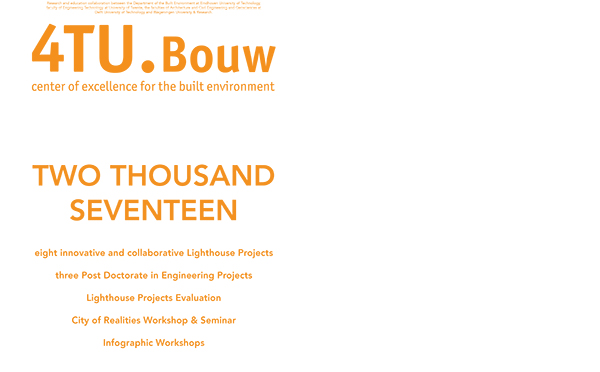
4TU.Bouw 2017
2018 / English, Dutch
Results from seven 4TU.Bouw Lighthouse Projects, PDEng projects and all 4TU.Bouw initiatives in 2017.
editor
Siebe Bakker
graphic design: Siebe Bakker
Backflap (EN)
4TU.Bouw represents the collaboration between the four Technical Universities in the Netherlands on the large topic of ‘The Built Environment’. The cooperation consists of the Department of the Built Environment at Eindhoven University of Technology, the faculty of Engineering Technology at University of Twente, the faculties of Architecture and Civil Engineering and Geosciences at Delft University of Technology and Wageningen University & Research. The goal of the 4TU.Bouw initiative is to promote collaboration between the member faculties, industrial partners and government, in order to meet the grand challenges ahead.
Built Environment is the biotope of the modern citizen, providing infrastructure for transport, defence against flooding, shelter, space for working, meeting and leisure activities, etc. The demands upon reliability, safety and comfort of these structures is continuously increasing.
Meanwhile the Built Environment sector is confronted with enormous challenges like scarcity of resources, climate change, accelerated population growth and demographic changes. These challenges require joint strategies and collaboration between end-user, academia, the industry and governmental agencies, the so-called golden triangle.
Therefore, in the context of the Dutch ‘Nationale Wetenschapsagenda’, 4TU.Bouw, with its partners, has identified the important, societal and scientifically relevant research themes: ‘De Toekomst Wordt Gebouwd’, as well as the ‘Built Society Smart Reality’ urgency and ambition ‘map’.
Relevant themes have been utilized as context for the 4TU.Bouw Lighthouse programmes 2016 and 2017. In 2017 eight dedicated, fast track innovation projects have been completed, all addressing aspects of the agenda and map. These projects provide a proof of concept – or failure – of new technologies that will contribute to solid approaches and solutions to the challenges ahead, for all stakeholders.
Also, a dedicated PDEng-training programme contributes to the future availability of well-trained specialists, meanwhile bridging thegap between academia and the market. 4TU.Bouw strives to respond rapidly to the ever faster changes, often emerging bottom-up, that new technologies bring about, by organizing workshops, brainstorms and training sessions with relevant stakeholders, and by forming dedicated consortia that act jointly. Only by such joint actions with respect to the urgent themes are positive changes expected to happen.
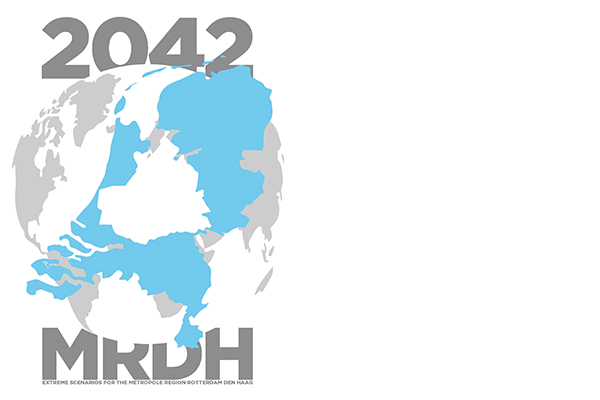
Delft Scenarios 05 - MRDH
2017 / English
Results from the Delft Scenarios 05 'Design Thinking' studio for students of the University of Kentucky - College of Design. The studio explored plausibele scenarios for the municipality of Delft, reflecting on it's future position witinh the Metropole Region Rotterdam Den Haag. Four scenarios are presented. Contributions by Micah Johnson, Trevor Tanzi & Emily Taylor
editor
Siebe Bakker
graphic design: Siebe Bakker, Micah Johnson, Trevor Tanzi & Emily Taylor
Backflap (EN)
Design Thinking
Cities all over the world are reinventing their positions, either driven by changes in national policies decentralizing governance or reacting to the reality of competition and collaboration on subjects such as economy, services or the changing number of inhabitants.
Often this is generated out of a desire or perceived necessity to respond to the changing ambitions of industries and citizens. One only has to think of notions like ‘Creative Cities’, ‘Metropolitan Regions’, ‘City Branding’ and ‘Self-regulation’ to understand that traditional ways to organize one’s community will fail to adequately address these emerging ambitions.
There is a need to improve decision-making and policy processes just as much as there is a need to service and renew spatial structures as demands are changing. One can state that changes in urban developments are driven by changes in population and their needs. Energy and sustainability issues have become a common consciousness deserving appropriate response in terms of policy and spatial planning. One can easily add to these examples.
These current challenges are becoming more complex and interwoven. Fed by a large number of sometimes contradictory and definitely various ambitions, they need to be addressed in a manner that do justice to all involved. Changes are good. And by nature, changes are complex and difficult to implement. They are disruptive and evoke resistance. Change needs community, involvement, and commitment. The more complex a challenge is, the more actors or stakeholders need to be involved, and the more inadequate traditional means for development becomes.
One needs to build robust solutions, or better, robust environments and contexts. Solutions tend to address current situations incapable of adjusting to changing realities. It is exactly those rapidly changing realities – economical, political and social – that have led to the realization that innovation in governance and policy-making processes is crucial for a city to keep operating successfully. Intelligent ways to address and implement developments are needed. Intelligent in terms of creating efficient and economically viable solutions for both processes and implementations; intelligent as in being informed by relevant parties.
Current notions on ‘Design Thinking’ move towards inclusive and collaborative processes. These are aimed at efficiently producing inventories and analyses of stakeholders and context. Organizing effective prototyping presents essentially different strategic options and scenarios.
Finally and foremost, these processes create collaborative structures for professionals, administrators and citizens.
Studio
MRDH2042 is a case study basedresearch & design program. Students from the University of Kentucky - College of Design took on the challenge to research potential interventions for the municipality of Delft. Current ambitions and trends involve the position of the city of Delft in the upcoming Region Metropole Rotterdam Den Haag, the relation between the Delft University of Technology and the city itself and generic European challenges as changes in population, economy and resilience topics like environmental and social
The research includes the current condition of Delft in relation to the region and in comparison to similar cities in Europe and the US. Main focus for the development of various scenarios is to enhance opportunities and ambitions with a special interest to the built environment.
Although the subject of research is realistic and based on actual ambitions and challenges the MRDH2042 studio produces ‘academic’ results. It is not our aim to provide ‘ready-to-use’ solutions for either the municipality of Delft or other stakeholders. Our results are based on an open and suggestive approach and can be as extreme in terms of content and implementation conditions (financially, political, etc.) as the research and development of scenarios dictate. As much as the developed scenarios and proposed (spatial) implementations are grounded in actual conditions and political, economical or cultural ambitions they are meant to question and unveil exactly those premises.
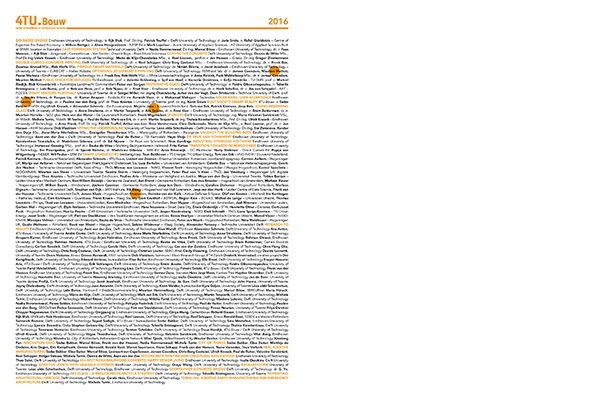
4TU.Bouw 2016
2017 / English, Dutch
Results from seven 4TU.Bouw Lighthouse Projects, 3 PDEng projects and all 4TU.Bouw initiatives in 2016.
editor
Siebe Bakker
graphic design: Siebe Bakker & Elise Buiter
Backflap (EN)
4TU.Bouw represents the collaboration between the four Technical Universities in the Netherlands on the large topic of ‘The Built Environment’. The cooperation consists of the Department of the Built Environment at TU Eindhoven, the faculty of Engineering Technology at Twente University, the faculties of Architecture and Civil Engineering and Geosciences at TU Delft and Wageningen University.
The goal of the 4TU.Bouw initiative is to promote collaboration between the member faculties, industrial partners and government, in order to meet the grand challenges ahead.
Built Environment is the biotope of the modern citizen, providing infrastructure for transport, defence against flooding, shelter, space for working, meeting and leisure activities, etc. The demands upon reliability, safety and comfort of these structures is continuously increasing. Meanwhile the Built Environment sector is confronted with enormous challenges like scarcity of resources, climate change, accelerated population growth and demographic changes. These challenges require joint strategies and collaboration between end-user, academia, the industry and governmental agencies, the so-called golden triangle. Therefore, in the context of the Dutch ‘Nationale Wetenschapsagenda’, 4TU.Bouw, with its partners, has identified the important, societal and scientifically relevant research themes: ‘De Toekomst Wordt Gebouwd’, as well as the ‘Built Society Smart Reality’ urgency and ambition ‘map’.
Relevant themes have been utilized as context for the 4TU.Bouw Lighthouse programmes 2016 and 2017. In 2016 fifteen dedicated, fast track innovation projects have been completed, all addressing aspects of the agenda and map. These projects provide a proof of concept – or failure – of new technologies that will contribute to solid approaches and solutions to the challenges ahead, for all stakeholders. In 2017 eight more Lighthouse Projects will start. Also, a dedicated PDEng-training programme contributes to the future availability of well-trained specialists, meanwhile bridging the gap between academia and the market. 4TU.Bouw strives to respond rapidly to the ever faster changes, often emerging bottom-up, that new technologies bring about, by organizing workshops, brainstorms and training sessions with relevant stakeholders, and by forming dedicated consortia that act jointly. Only by such joint actions with respect to the urgent themes are positive changes expected to happen.
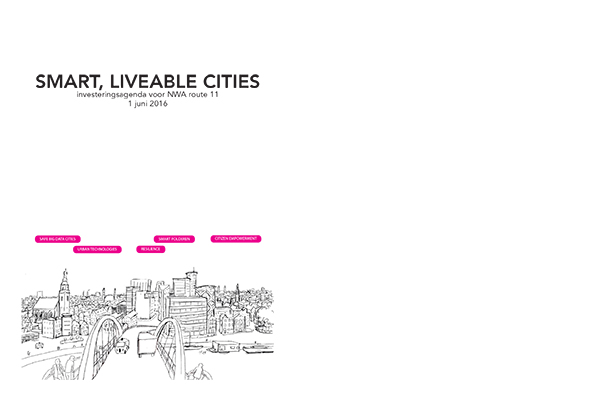
SMART, LIVEABLE CITIES
2016 / Dutch
Position paper on collaborative - academia, industry and social entities - ambitions on Smart Cities research programs.
editor
Siebe Bakker
graphic design: Siebe Bakker, Elise Buiter, Dré Kampfraath & Frans Schupp
Welkom in de slimme stad (NL)
Welkom in de slimme stad
Een reeds lang ingezette, en wereldwijde, trend is die van de toenemende concentratie in stedelijke gebieden (metropolen) en omliggende regio’s, terwijl elders juist regio’s leeglopen en krimpen. In 2050 zal zo’n 70% van de wereldbevolking in een stedelijke omgeving wonen, die dan goed zijn voor bijna 80% van het bruto wereldproduct (global GDP). De trend van toenemende verstedelijking lijkt onstuitbaar, en vanuit efficiency optiek ook verklaarbaar: stedelijk leven leidt tot schaalvoordelen. Zo zal bij een verdubbeling van de stedelijke bevolkingsomvang slechts 85% extra infrastructuur nodig zijn. Maar de stad is ook een concentratie van mensen, die streven naar comfort en gemak, maar vooral een vervuld en plezierig leven willen leiden, waarin gezondheid, sociaal contact, geborgenheid, verbondenheid, individuele ontplooiing maar ook ‘ergens bij horen’, etc., voorop staan; bruto stedelijk geluk. De nieuwe, zich steeds sneller ontwikkelende digitale verbinding tussen mensen onderling, tussen mens en omgeving, en tussen objecten onderling – de digitale laag, een nieuwe dimensie van de stad die het aspect smart laadt -kan zorgen voor extra schaalvoordelen van het leven in de stad. Tegelijkertijd zal dit leiden tot versterking van de economische vitaliteit èn leefbaarheid van de stad. Overigens, de inwoners van krimp- en buitengebieden zullen vanzelfsprekend profiteren van dezelfde ‘smart technologieën’ die smart cities leefbaar en dynamisch maken.
Kortom, het stedelijk leven wint steeds meer aan belang; een aanzienlijk deel van de sociale interactie, innovatie en culturele ontwikkeling vindt hier plaats. De verdichting, die inherent is aan het stedelijk leven, brengt echter ook aanzienlijke maatschappelijke uitdagingen met zich mee, die zich manifesteren op verschillende schaalniveaus (gebouw, buurt, wijk, stad, regio, land). Deze zijn door veelheid aan onderlinge interacties en onderlinge verwevenheid complex van aard. Naast genoemde maatschappelijke uitdagingen, is een adequaat antwoord op de schaarste-problematiek rond (openbare) ruimte, schoondrinkwater, voedselproductie, een schoon en gezond milieu, energie en grondstoffen, cruciaal voor het uitbouwen van het succes van de stad als gunstig biotoop voor de mens, en andere levensvormen. Daarnaast bepalen lange termijn ontwikkelingen, zoals klimaatverandering, demografische bewegingen (o.m. vergrijzing en vergroening), voortgaande digitalisering en toenemende individuele mobiliteit, de houdbaarheid van het stedelijk succes. Dit vraagt om antwoorden die een geïntegreerde aanpak vereisen op zowel technisch, sociaal, ecologisch en economisch vlak. Er zal daarbij uitgegaan moeten worden van de bestaande stad; de bestaande gebouwde omgeving, de bestaande inwoners van een stad, de bestaande stadsecologie en de institutionele structuren zijn een gegeven. De NWA-route Smart, liveable cities staat een integrale, multidimensionale aanpak voor, waarbij zowel de kansen als de bedreigingen voor de stad worden geadresseerd, voor nu en voor later. Daarvoor zijn nieuwe samenwerkingsvormen nodig, waartoe de diverse vakgebieden hun krachten bundelen, naar elkaar luisteren en van elkaar leren. Om in gezamenlijkheid te anticiperen en nieuwe contouren te schetsen voor een wereld, en een stad, waar het goed leven is voor de mens, zo goed mogelijk in harmonie met zijn natuurlijke omgeving. Een stedelijk leven.
Vernieuwende verbindingen
Een viertal deelperspectieven ten aanzien van de zich ontwikkelende stad is gebruikt om de brede scope en het verband tussen de vele en diverse aspecten binnen deze route, te identificeren. Vanuit de verscheidenheid aan wetenschappelijke disciplines, was het uitgangspunt om maximaal vernieuwende verbindingen tussen disciplines, instituten, tussen wetenschap, maatschappij en bedrijfsleven te identificeren en samen te brengen. De samenhang tussen de deelperspectieven is in essentie de uitdaging waartoe onderzoekers, onderzoeksinstellingen, bedrijfsleven en andere stakeholders gesteld zijn. Samenwerking en nieuwe verbindingen zijn noodzakelijk om de diverse deelperspectieven door nieuwe inzichten, technologieën en bestuursarrangementen te doen convergeren naar een leefbare stedelijke omgeving voor zoveel mogelijk mensen.
• Menselijke Stad – Zonder mensen geen stad. Alleen met een optimaal leefklimaat voor mensen kunnen steden floreren. Mensen moeten gezond, gelukkig, veilig en met elkaar kunnen leven. Aandacht voor een goed leefmilieu,sociale cohesie, inclusiviteit, betrokkenheid, een toereikend inkomen en een gezond ondernemersklimaat zijn hierbij van belang.
• Georganiseerde Stad - De huidige, snelle technologische ontwikkelingen zullen ook verstrekkende gevolgen hebben voor de organisatie van steden. Nieuwe technologie geeft nieuwe mogelijkheden voor participatie in besluitvorming, en andere vormen van communicatie en samenwerking tussen bestuursorganen, onderling en met burgers en belangengroepen mogelijk maken. Het is daarom van groot belang beter inzicht te krijgen in de organisatie - en politieke structuur - van steden, hoe deze zich ontwikkelen en wat de consequenties zijn van de steeds grotere beschikbaarheid en invloed van nieuwe technologie.
• Onzichtbare Stad - Veel, met name digitale, ontwikkelingen in smart cities onttrekken zich aan het blote oog. Sensor- en registratietechnologie, sociale media en e-government vormen een nieuwe, digitale data laag in de stad. Dat vraagt om herbezinning op verhoudingen, inrichting en ‘governance’ van deze nieuwe laag, en het nieuwe spanningsveld tussen privacy en publiek belang. Privacy en (cyber)veiligheid zijn basiswaarden om de smart city ook liveable te houden.
• Tastbare Stad - Een stad is ook een verzameling van gebouwde dingen, van systemen en infrastructuren (zoals verkeer, data, energie, groen en water) die samen beslag leggen op een deel van de schaarse ruimte van een stad, voor kortere of juist zeer lange tijden. De toenemende druk op de stad vraagt om fysieke innovaties die veranderende mobiliteits-patronen, in het stedelijk weefsel geïntegreerd duurzaam gebruik van energie en grondstoffen, klimaatbestendigheid, diversiteit, gezondheid, demografische ontwikkelingen en andere urbane uitdagingen op een houdbare wijze mogelijk maken. Hierbij is het van belang om reeds vanaf de ontwerptafel systemen zo vorm te geven dat ze nog onbekende toekomstige ontwikkelingen kunnen accommoderen.
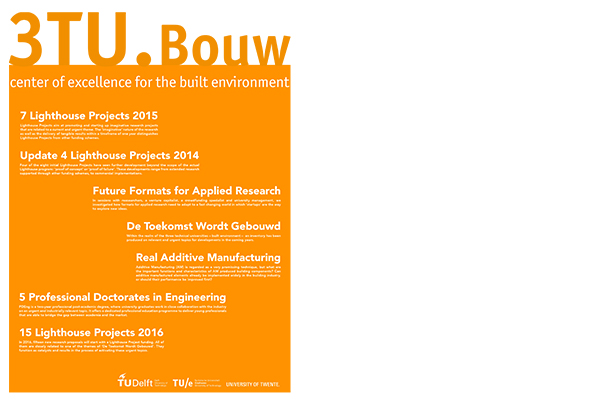
3TU.Bouw 2015
2016 / English, Dutch
Results from seven 3TU.Bouw Lighthouse Projects, 5 PDEng projects and all 3TU.Bouw initiatives in 2015.
editor
Siebe Bakker
graphic design: Siebe Bakker & Mariet Sauerwein
Backflap (EN)
3TU.Bouw represents the collaboration between the 3 Technical Universities in the Netherlands on the large topic of ‘The Built Environment’. The cooperation consists of the Department of the Built Environment at TU Eindhoven, the faculty of Engineering Technology at Twente University, and the faculties of Architecture and Civil Engineering and Geosciences at TU Delft. The goal of the 3TU.Bouw initiative is to promote collaboration between the member faculties, industrial partners and government, in order to meet the grand challenges ahead.
Built Environment is the biotope of the modern citizen, providing infrastructure for transport, defence against flooding, shelter, space for working, meeting and leisure activities, etc. The demands upon reliability, safety and comfort of these structures is continuously increasing. Meanwhile the Built Environment sector is confronted with enormous challenges like scarcity of resources, climate change, accelerated population growth and demographic changes. These challenges require joint strategies and collaboration between end-user, academia, the industry and governmental agencies, the so-called golden triangle. Therefore, in the context of the Dutch ‘Nationale Wetenschapsagenda’, 3TU.Bouw, with its partners, has identified the important, societal and scientifically relevant research themes: ‘De Toekomst Wordt Gebouwd’.
These themes have been utilized as context for the 3TU.Bouw Lighthouse programme 2016: fifteen dedicated, fast track innovation projects have been started, all addressing aspects of the agenda. These projects should provide a proof of concept – or failure – of new technologies that will contribute to solid approaches and solutions to the challenges ahead, for all stakeholders. Next to this, a dedicated PDEng-training programme contributes to the future availability of well-trained specialists, meanwhile bridging the gap between academia and the market. 3TU.Bouw strives to respond rapidly to the ever faster changes, often emerging bottom-up, that new technologies bring about, by organizing workshops, brainstorms and training sessions with relevant stakeholders, and by forming dedicated consortia that act jointly. Only by such joint actions positive changes with respect to the urgent themes are expected to happen.
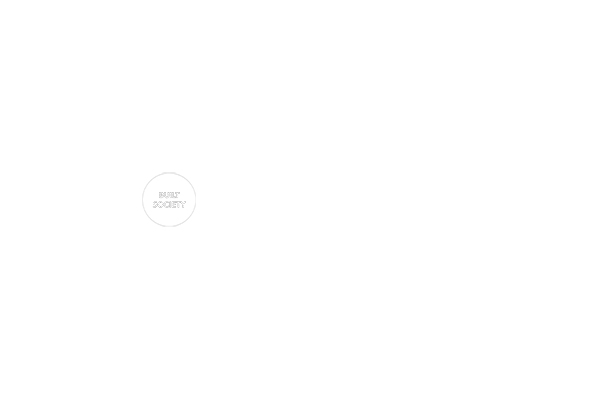
built society smart reality
2016 / Dutch
3TU.Bouw together with Bouwend Nederland and De Bouwcampus compiled the start of relevant 'To Do's' for the built environment sector for the next decades. These are based on topics gathered from professionals and researchers and embedded within current and near-future' urgencies.
editors
Siebe Bakker, Tom van Eck, Patrick Koimans & Alexander Schmets
graphic design: Siebe Bakker, Dré Kampfraath & Mariet Sauerwein
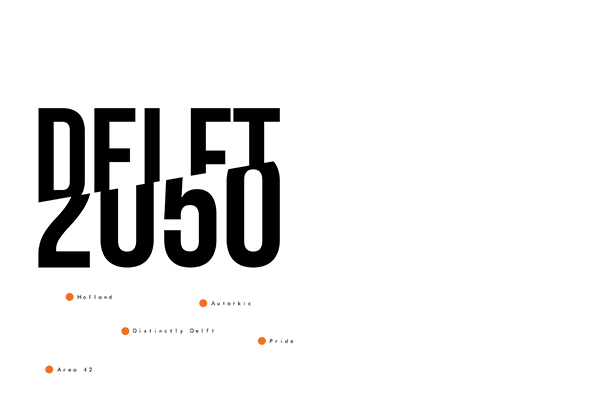
Delft Scenarios 03 - Delft 2050
2017 / English
Results from the Delft Scenarios 03 'Design Thinking' studio for students of the University of Kentucky - College of Design. The studio explored plausibele scenarios for the municipality of Delft, reflecting on it's future position witinh the Metropole Region Rotterdam Den Haag. Five scenarios are presented. Contributions by Arden Cooper, Zhulin He, Morgan McKinney, Amanda Olix & Olivia VonBokel.
editor
Siebe Bakker
graphic design: Siebe Bakker, Arden Cooper, Zhulin He, Morgan McKinney, Amanda Olix & Olivia VonBokel
Introduction (EN)
Design thinking
Cities all over the world are reinventing their positions, either driven by changes in national policies decentralizing governance or reacting to the reality of competition and collaboration on subjects such as economy, services or the changing number of inhabitants. Often this is generated out of a desire or perceived necessity to respond to the changing ambitions of industries and citizens. One only has to think of notions like ‘Creative Cities’, ‘Metropolitan Regions’, ‘City Branding’ and ‘Self-regulation’ to understand that traditional ways to organize one’s community will fail to adequately address these emerging ambitions.
There is a need to improve decision-making and policy processes just as much as there is a need to service and renew spatial structures as demands are changing. One can state that changes in urban developments are driven by changes in population and their needs. Energy and sustainability issues have become a common consciousness deserving appropriate response in terms of policy and spatial planning. One can easily add to these examples. These current challenges are becoming more complex and interwoven. Fed by a large number of sometimes contradictory and definitely various ambitions, they need to be addressed in a manner that justifies all involved. Changes are good. And by nature, changes are complex and difficult to implement. They are disruptive and evoke resistance Change needs community, involvement, and commitment. The more complex a challenge is, the more actors or stakeholders need to be involved, and the more inadequate traditional means for development becomes.
One needs to build robust solutions, or better, robust environments and contexts. Solutions tend to address current situations incapable of adjusting to changing realities. It is exactly those rapidly changing realities – economical, political and social – that have led to the realization that innovation in governance and policy-making processes is crucial for a city to keep operating successfully. Intelligent ways to address and implement developments are needed. Intelligent in terms of creating efficient and economically viable solutions for both processes and implementations; intelligent as in being informed by relevant parties.
Current notions on ‘Design Thinking’ move towards inclusive and collaborative processes. These are aimed at efficiently producing inventories and analyses of stakeholders and context. Organizing effective prototyping presents essentially different strategic options and scenarios. Finally and foremost, these processes create collaborative structures for professionals, administrators and citizens.
Studio
During the past years the municipality of Delft has conducted several studies into aspects of Delft as a knowledge city, their relationwith the Techniocal University Delft and more recently finacial challenges due to the global crises.
Delft Scenarios 03 is a casestudy based research program investigating the future of Delft. Students from the University of Kentucky took on the challenge to research potential interventions for the municipality of Delft in a global, European and regional context. Inventory of ambitions, foresights and perceptions led to a number of SWOT-analyses, both from the perspective of the individual stakeholders as well as on a ‘macro level’. Scenario specific information was collected and implemented in more precise descriptions of plausible futures for Delft. The scenarios present extreme positions aimed to unveil current conditions and realistic future situations. They operate as context to test current plans on their robustness and adaptability to remain significant regardless of how the future actually unfolds.
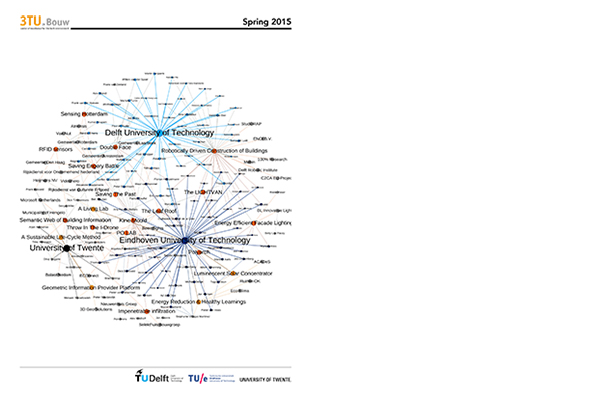
3TU.Bouw 2014 - Spring 2015
2015 / English, Dutch
Results from eight 3TU.Bouw Lighthouse Projects and PDEng projects
editor
Siebe Bakker
graphic design: Siebe Bakker & Anna Karina Janssen
Backfklap (EN)
Most of the more persistent man-made structural assets that surround us in everyday life as well as their reliable structural services are normally taken ‘as a law of nature’ by the general public. Compared to consumer products the service levels of structural assets are extremely high. Bridges with a structural failure rate comparable to that of normal office printers would be considered completely unacceptable, while a tunnel would never be built if they had a service life expectance comparable to the most long lasting functional products such as (certain) washing machines or Hi-Fi-systems. The same holds for all build structures, including houses, public and commercial buildings.
Meanwhile these structural assets together exceed in financial terms the balance of any global financial institution, or the yearly budget of e.g. the Dutch government many times. Thus, the importance and impact of the broad field of science and engineering related to the built environment - which includes architecture, architectural engineering, civil engineering, process management and policy - is not be underestimated, both economically and socially.
Notwithstanding the evident importance of the Built Environment sector, the public perception of this sector is not that positive, a trend that has been developing in the past few decades. The public perception of the sector often leans towards non-innovative, somewhat clumsy, disorganised and conservative.
It is often forgotten that inventions and innovations from any field of science and engineering are finally applied in the context of the built environment. Developments with respect to e.g. energy comfort, new building materials and systems are spectacular. For instance, no other innovation has increased life expectancy of people as much as the broad application of developments in sanitary engineering. It is even so, that the difference between developed and developing countries can be largely attributed to the quality of public sanitation systems. Apparently, the development of an adequate and efficient sanitation system requires the effective collaboration within the so-called ‘Golden Triangle’, i.e. stable and facilitating governments, trained people and innovation originating from educational and scientific institutions and energetic application by these innovations by the market.
Moreover, the environmental impact of the ‘building sector’ is huge, given the enormous usage of raw materials. Together with the energy sector, the building sector is at the forefront of addressing great societal challenges related to sustainability, scarcity and availability of raw materials as well as the transition towards a circular economic model, based on recycling and upcycling of waste materials and structures.
Another development is the need for true multidisciplinary and cross-disciplinary collaboration on these challenges. Almost every field of science and engineering has found its application in the built environment. Developments within quantum mechanics has led to diverse developments like energy efficient lighting (LED), precise positioning and cutting (laser technologies) and of course to the revolutionary introduction of ICT in the built environment. Developments in (micro-) biology has led to the aforementioned sanitation revolution, whereas new insights in the mathematics of planning and operations research allowed building processes at scales that would have never been possible before.
An effective and multidisciplinary approach faces grand challenges ahead, requiring dedication and collaboration. Therefore the three technical universities decided to collaborate – amongst others – as 3TU.Bouw Center of Excellence for the Built Environment. The 3TU.Bouw Center of Excellence consists of the Department of the Built Environment at Eindhoven University of Technology, the faculty of Engineering Technology at Twente University, and the faculties of Architecture and Civil Engineering and Geosciences at Delft University of Technology.
The overall goal of this 3TU initiative is to promote close collaboration between Dutch universities in order to increase competitiveness in international research and education, and to concentrate research and education efforts to improve efficiency and scientific excellence.
At present 3TU.Bouw concentrates on two major developments: innovation with respect to energy efficiency in the built environment, and providing dedicated professional education programmes to deliver young professionals that are able to bridge the gap between academia and the market.
The latter is achieved by the so-called PDEng–programme. Within 3TU.Bouw a dozen of these projects have been started in 2014 and a similar number will be initiated in 2015. Industrial partners are always welcome to propose PDEng projects that can be jointly pushed forward within the context of the 3TU.Bouw PDEng-programme.
The 3TU.Bouw focus on innovation with respect to energy efficiency in the built environment is achieved through a programme that is called the ‘3TU.Bouw Lighthouse Projects’ programme. 3TU.Bouw ‘Lighthouse Projects’ aims at promoting and starting up imaginative research projects that are related to the theme ‘Energy and the Built Environment’. The ‘imaginative’ nature of the research as well as the delivery of tangible results (e.g. prototypes, test environments, and so on) distinguishes Lighthouse Projects from other funding schemes.
The preliminary project ideas and results of a series of Lighthouse projects, started only in the second half of 2014, are presented in this publication together with the context of a few of the PDEng-projects started in the same year. It should be noted that success of 3TU.Bouw does not mean that (all) initial project goals are met: a good failure can be a huge success and may generate, in the long run, more impact than a successful project with a more limited scope.
The ‘Week van de Bouw’ is one of those opportunities where we can stand together; academics and industry, contractors and asset owners, students and experienced professionals. Let’s synergise, combine and cross-fertilize our expertise to solve future challenges, while being grateful and proud with everything achieved already by our colleagues of the past generations.
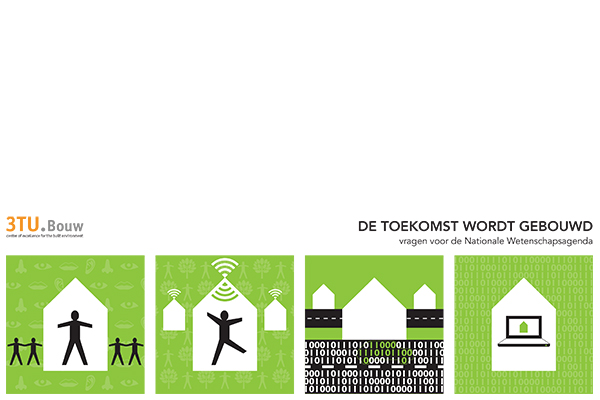
de toekomst wordt gebouwd
2015 / Dutch
In reaction to the call by the Dutch National Science program for future and relevant resercah topics, an inventory was made among researchers from the three technical universities (built environment).
editor
Siebe Bakker, Lisa Kuijpers & Alexander Schmets
graphic design (icons): Dré Kampfraath & Frans Schupp
graphic design: Siebe Bakker & Anna Karina Janssen
Introductie (NL)
Nederland is het resultaat van een eeuwenlang bouwproces, Nederland is het resultaat van maatwerk gedurende vele eeuwen. Er is land gewonnen, er is land verdedigd tegen het water, er zijn steden en dorpen gebouwd, er is infrastructuur gebouwd: van wegen en dijken, van polders en luchthavens. Mensen beleven het land, de ruimte, het (binnen) klimaat van gebouwen, en hebben verbinding met anderen via fietspad, spoor, snelweg, digital highway, water uit de kraan, vuil naar het stort en waterzuivering, elektriciteit voor levensbehoeften en luxe, droge voeten, veilige havens - een greep uit vanzelfsprekendheden die mede mogelijk gemaakt zijn door de bouw en civiele techniek.
De ontwikkeling van de samenleving en de technologie vragen voortdurend aanpassing van de fysieke leefomgeving. Voorspellingen over de gevolgen van klimaatverandering zoals zeespiegelstijging, de noodzakelijke transitie naar decentrale, duurzame energieproductie en de noodzaak tot een gesloten kringloop voor grondstoffen, maakt een versnelde ontwikkeling en toepassing van innovaties in de gebouwde omgeving van groot belang, voor de huidige generaties, en alle die volgen.
Desondanks kampt de bouw met het imago conservatief en versnipperd te zijn. Echter, de constructieve zekerheid van producten van de bouwsector zijn formidabel (voor infrastructurele objecten als waterkeringen is 100 jaar een absoluut minimum), de ontwikkelingen in de afgelopen decennia ten aanzien van energiecomfort en – zuinigheid, nieuwe, slimme bouwmaterialen zijn spectaculair te noemen. De bouwsector is bij uitstek de omgeving waarin de innovaties uit talrijke vakgebieden in geïntegreerde vorm hun uiteindelijke toepassing vinden. Zo heeft bijvoorbeeld geen enkele innovatie zoveel kwaliteitsjaren aan het leven van de mens toegevoegd als adequate sanitatie in zijn leefomgeving. Publieke sanitatie is een goed voorbeeld van een historisch, en ‘ongoing’, project dat alleen tot stand kon komen door effectieve werking van de gouden driehoek tussen normstellende en faciliterende overheden, voortschrijdende inzichten vanuit onderwijs en wetenschappen, en voortvarende uitvoering door de private sector.
Daarom heeft het samenwerkingsverband van bouw-faculteiten van de drie Technische Universiteiten in Nederland, 3TU.Bouw, in nauwe afstemming met de bouwsector en de hele bouw gerelateerde onderwijsketen, een 8-tal thema’s geagendeerd die richtinggevend zullen zijn voor toekomstig wetenschappelijk en onderzoek. Op basis van deze thema’s zijn vragen geformuleerd voor de Nationale Wetenschapsagenda, welke in de volgende pagina’s gepresenteerd worden. De toekomst wordt gebouwd!
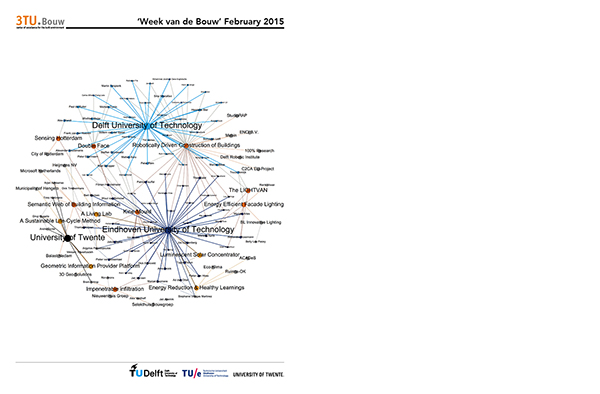
3TU.Bouw 2014 - Week van de Bouw
2015 / English, Dutch
Results from eight 3TU.Bouw Lighthouse Projects and PDEng projects
editor
Siebe Bakker
graphic design: Siebe Bakker & Anna Karina Janssen
3TU.Bouw 2014 (EN)
Most of the more persistent man-made structural assets that surround us in everyday life as well as their reliable structural services are normally taken ‘as a law of nature’ by the general public. Compared to consumer products the service levels of structural assets are extremely high. Bridges with a structural failure rate comparable to that of normal office printers would be considered completely unacceptable, while a tunnel would never be built if they had a service life expectance comparable to the most long lasting functional products such as (certain) washing machines or Hi-Fi-systems. The same holds for all build structures, including houses, public and commercial buildings.
Meanwhile these structural assets together exceed in financial terms the balance of any global financial institution, or the yearly budget of e.g. the Dutch government many times. Thus, the importance and impact of the broad field of science and engineering related to the built environment - which includes architecture, architectural engineering, civil engineering, process management and policy - is not be underestimated, both economically and socially.
Notwithstanding the evident importance of the Built Environment sector, the public perception of this sector is not that positive, a trend that has been developing in the past few decades. The public perception of the sector often leans towards non-innovative, somewhat clumsy, disorganised and conservative.
It is often forgotten that inventions and innovations from any field of science and engineering are finally applied in the context of the built environment. Developments with respect to e.g. energy comfort, new building materials and systems are spectacular. For instance, no other innovation has increased life expectancy of people as much as the broad application of developments in sanitary engineering. It is even so, that the difference between developed and developing countries can be largely attributed to the quality of public sanitation systems. Apparently, the development of an adequate and efficient sanitation system requires the effective collaboration within the so-called ‘Golden Triangle’, i.e. stable and facilitating governments, trained people and innovation originating from educational and scientific institutions and energetic application by these innovations by the market.
Moreover, the environmental impact of the ‘building sector’ is huge, given the enormous usage of raw materials. Together with the energy sector, the building sector is at the forefront of addressing great societal challenges related to sustainability, scarcity and availability of raw materials as well as the transition towards a circular economic model, based on recycling and upcycling of waste materials and structures.
Another development is the need for true multidisciplinary and cross-disciplinary collaboration on these challenges. Almost every field of science and engineering has found its application in the built environment. Developments within quantum mechanics has led to diverse developments like energy efficient lighting (LED), precise positioning and cutting (laser technologies) and of course to the revolutionary introduction of ICT in the built environment. Developments in (micro-) biology has led to the aforementioned sanitation revolution, whereas new insights in the mathematics of planning and operations research allowed building processes at scales that would have never been possible before.
An effective and multidisciplinary approach faces grand challenges ahead, requiring dedication and collaboration. Therefore the three technical universities decided to collaborate – amongst others – as 3TU.Bouw Centre of Excellence for the Built Environment. The 3TU.Bouw Center of Excellence consists of the Department of the Built Environment at Eindhoven University of Technology, the faculty of Engineering Technology at Twente University, and the faculties of Architecture and Civil Engineering and Geosciences at Delft University of Technology. The overall goal of this 3TU initiative is to promote close collaboration between Dutch universities in order to increase competitiveness in international research and education, and to concentrate research and education efforts to improve efficiency and scientific excellence.
At present 3TU.Bouw concentrates on two major developments: innovation with respect to energy efficiency in the built environment, and providing dedicated professional education programmes to deliver young professionals that are able to bridge the gap between academia and the market.
The latter is achieved by the so-called PDEng–programme. PDEng is a two-year professional, post-academic degree, where university graduates work in close collaboration with the industry on an urgent and industrially relevant topic. Within 3TU.Bouw a dozen of these projects have been started in 2014 and a similar number will be initiated in 2015. Industrial partners are always welcome to propose PDEng projects that can be jointly pushed
forward within the context of the 3TU.Bouw PDEng-programme.
The 3TU.Bouw focus on innovation with respect to energy efficiency in the built environment is achieved through a programme that is called the ‘3TU.Bouw Lighthouse Projects’ programme. 3TU.Bouw ‘Lighthouse Projects’ aims at promoting and starting up imaginative research projects that are related to the theme ‘Energy and the Built Environment’. The ‘imaginative’ nature of the research as well as the delivery of tangible results (e.g. prototypes, test environments, and so on) distinguishes Lighthouse Projects from other funding schemes. The relatively short project term of 3TU.Bouw Lighthouse Projects – tangible results within a year – appeals to ‘fast-track’ and ‘high-risk’ proposals. 3TU.Bouw Lighthouse projects aim at various levels of integration with industry and enduser parties.
The preliminary project ideas and results of a series of Lighthouse projects, started only in the second half of 2014, are presented in this publication together with the context of a few of the PDEngprojects started in the same year. It should be noted that success of 3TU.Bouw does not mean that (all) initial project goals are met: a good failure can be a huge success and may generate, in the long run, more impact than a successful project
with a more limited scope.
The ‘Week van de Bouw’ is one of those opportunities where we can stand together; academics and industry, contractors and asset owners, students and experienced professionals. Let’s synergise, combine and cross-fertilize our expertise to solve future challenges, while being grateful and proud with everything achieved already by our colleagues of the past generations.
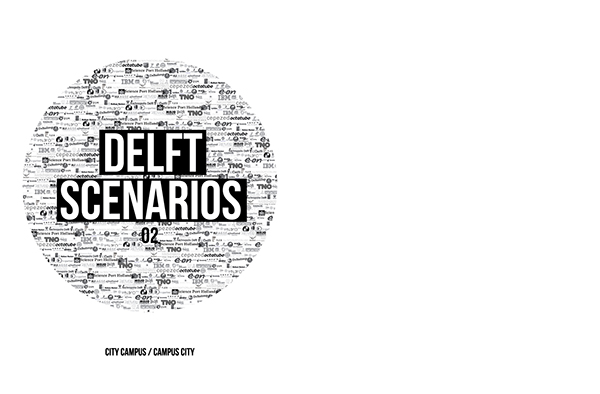
Delft Scenarios 02 - City=Campus, Campus=City
2014 / English
Results from the Delft Scenarios 02 'Design Thinking' studio for students of the University of Kentucky - College of Design and University Leiden - public administration. The studio explored plausibele scenarios for the municipality of Delft, reflecting on it's ambition to develop the relation between the Technical University and the city; 'City=Campus, Campus=City'. Five scenarios are presented. Contributions by Kevin Bloomfield, Madeline Cunningham, Oliver Hidalgo, Lauren Townsend & Sarah Wagner.
editor
Siebe Bakker
graphic design: Siebe Bakker, Kevin Bloomfield, Madeline Cunningham, Oliver Hidalgo, Lauren Townsend & Sarah Wagner
Delft Scenarios 02 (EN)
DESIGN THINKING
future scenarios and network governance
Cities all over the world are reinventing their positions,either driven by changes in national policies decentralizing governance or reacting to the reality of competition and collaboration on subjects such as economy, services or the changing number of inhabitants. Often this is generated out of a desire or perceived necessity to respond to the changing ambitions of industries and citizens. One only has to think of notions like ‘Creative Cities’, ‘Metropolitan Regions’, ‘City Branding’ and ‘Self-regulation’ to understand that traditional ways to organize one’s community will fail to adequately address these emerging ambitions.
There is a need to improve decision-making and policy processes just as much as there is a need to service and renew spatial structures as demands are changing. One can state that changes in urban developments are driven by changes in population and their needs. Energy and sustainability issues have become a common consciousness deserving appropriate response in terms of policy and spatial planning. One can easily add to these examples.
These current challenges are becoming more complex and interwoven. Fed by a large number of sometimes contradictory and definitely various ambitions, they need to be addressed in a manner that justifies all involved. Changes are good. And by nature, changes are complex and difficult to implement. They are disruptive and evoke resistance. Change needs community, involvement, and commitment. The more complex a challenge is, the more actors or stakeholders need to be involved, and the more inadequate traditional means for development becomes.
One needs to build robust solutions, or better, robust environments and contexts. Solutions tend to address current situations incapable of adjusting to changing realities. It is exactly those rapidly changing realities – economical, political and social – that have led to the realization that innovation in governance and policymaking processes is crucial for a city to keep operating successfully. Intelligent ways to address and implement developments are needed. Intelligent in terms of creating efficient and economically viable solutions for both processes and implementations; intelligent as in being informed by relevant parties.
Current notions on ‘Design Thinking’ move towards inclusive and collaborative processes. These are aimed at efficiently producing inventories and analyses of stakeholders and context. Organizing effective prototyping presents essentially different strategic options and scenarios. Finally and foremost, these processes create collaborative structures for professionals, administrators and citizens.
STUDIO
During the past years the municipality has conducted several studies into aspects of Delft as a knowledge city. Focussing on higher educated people, both students attending university and the colleges of higher vocational education (HBO), as well as knowledge workers who work for tech companies and knowledge institutions. Essential questions that surface are: what is the definition of a knowledge worker? What are the needs of higher educated people and how can you provide in those needs as a city? Although much is known about the topic, the municipality wants more input on the specific issue of their ‘City=Campus, Campus=City’ ambition. How can you further increase the attractiveness of Delft for higher educated people? How do you attract more knowledge workers? What is the best way to organize the network of stakeholders to accomplish shared goals?
Delft Scenarios 02 is a casestudy based research program investigating the abovementioned issue. Public administration students from Leiden University and architecture students from the University of Kentucky took on the challenge to research potential interventions for the municipality of Delft in the context of ‘City=Campus, Campus=City’.
The Leiden students started by conducting a series of interviews with representatives of various stakeholder groups in the city of Delft, including the municipaity itself. This inventory of ambitions, foresights and perceptions led to a number of SWOT-analyses, both from the perspective of the individual stakeholders as well as on the ‘macro level’ of the ‘City=Campus, Campus=City’ context. Subsequently these results were adopted by the students of the University of Kentucky to investigate further. Scenario specific information was collected and implemented in more precise descriptions of plausible futures for Delft. The scenarios present extreme positions aimed to unveil current conditions and realistic future situations. They operate as context to test current plans on their robustness and adaptability to remain significant regardless of how the future actually unfolds.
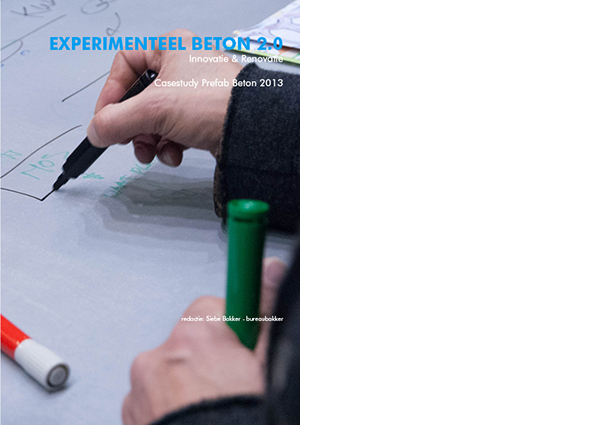 ]
]
Experimenteel Beton 2.0
2014 / Dutch
Results from the Prefab Concrete Casestudy 9.
editor & graphic design
Siebe Bakker
Backflap (NL)
De Casestudies worden ingezet om een brede groep ontwerpers in dialoog te brengen met de industrie. Een dialoog die niet bestaat uit louter informatie over bestaande mogelijkheden en kennismaking met de laatste toepassingen, maar één waarin aan de ontwerpers wordt gevraagd wat zij willen maken. Waarin hun ambities in discussie worden gebracht. De industrie zelf wordt hierbij ook gevraagd om bestaande en schijnbaar impliciete beperkingen qua productie en financiën in eerste instantie buiten beschouwing te laten. Elke vraag is mogelijk binnen de Casestudies. Elk voorstel wordt serieus en professioneel benaderd. Of het nu gaat om het reproduceren van een bestaand en exotisch voorbeeld, om een volledig nieuwe toepassing, een probleem dat in de praktijk van een ontwerper naar voren is gekomen of om een ware uitdaging aan de industrie om iets met beton te doen dat volledig lijkt in te druisen tegen de ‘natuurlijke’ hoedanigheid van het materiaal. Meer nog dan productontwikkeling pur sang zijn de Casestudies vooral een kennismaking en kruisbestuiving van verschillende culturen, die van ontwerpers en producenten.
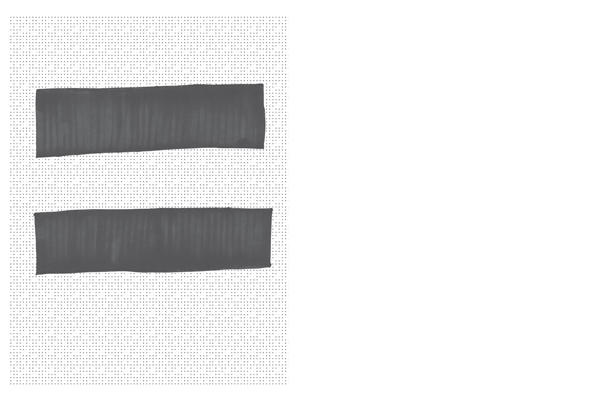
delft scenarios 01
2013 / English
Results from the Delft Scenarios 01 'Design Thinking' studio for students of the UNiversity of Kentucky - College of Design and University Leiden - public administration. The studio explored plausibele scenarios for the municipality of Delft, reflecting on it's ambition to develop into a 'Knowledge City' and to increase the retention of graduates from the Delft University of Technology. Five scenarios and a robust context for hybrid housing development are presented. Contributions by Zach Allen, Amanda Bryant, Laurel Christensen, Liz Feldman, Katie Gray & Jennifer Seymour
editor
Siebe Bakker
graphic design: Zach Allen, Siebe Bakker, Amanda Bryant, Laurel Christensen, Liz Feldman, Katie Gray & Jennifer Seymour
Delft Scenarios 01 (EN)
Cities all over the world are reinventing their positions; either driven by changes in national policies decentralizing governance or reacting to the reality of competition and collaboration on subjects such as economy, services or the changing number of inhabitants. This is often out of a desire or perceived necessity to respond to the changing ambitions of industries and citizens. One only has to think of notions like ‘Creative Cities’, ‘Metropolitan Regions’, ‘City Branding’ and ‘Self-regulation’ to understand that traditional ways to organize one’s community will fail to adequately address these emerging ambitions.
There’s a need to improve decision-making and policy processes just as much as there’s a need to service and renew spatial structures as demands are changing. One can state that changes in urban developments are driven by changes in population and their needs. Energy and sustainability issues have become a common consciousness deserving appropriate response in terms of policy and spatial planning. One can easily add to these examples.
design thinking
These current challenges are becoming more complex and interwoven. Fed by a large number of sometimes contradictory and definitely various ambitions they need to be addressed in a manner that justifies all involved. Changes are good. And by nature, changes are complex and difficult to implement. They are disruptive and evoke resistance. Change needs community, involvement and commitment. The more complex a challenge is, the more actors or stakeholders need to be involved, and the more inadequate traditional means to development becomes.
One needs to build robust solutions, or better, robust environments and contexts. Solutions tend to address current situations incapable of adjusting to changing realities. It is exactly those rapidly changing realities – economical, political and social – that have led to the realization that innovation in governance and policy- making processes is crucial for a city to keep operating successfully. Intelligent ways to address and implement developments are needed. Intelligent in terms of creating efficient and economically viable solutions for both processes and implementations; intelligent as in being informed by relevant parties.
Current notions on ‘Design Thinking’ move towards inclusive and collaborative processes. These are aimed at efficiently producing inventories and analyses of stakeholders and context. Organizing effective prototyping presents essentially different strategic options and scenarios. Finally and foremost, these processes create collaborative structures for professionals, administrators and citizens.
studio
Delft Scenarios 01 is a casestudy based research program. Public administration students from Leiden University and design students from the University of Kentucky took on the challenge to research potential interventions for the municipality of Delft. To gain a position as a ‘Knowledge City,’ Delft must improve the retention rate of local students, ultimately extending its population of well-educated residents.
The Leiden students started by conducting a series of interviews with representatives of the educational institutes in Delft, including students and student organizations, housing corporations and the municipality itself. This inventory of ambitions, foresights and perceptions guided by SWOT analyses and the identification of Driving Forces (happening for sure) and Critical Uncertainties (happening, but unsure how), led to a first indication of five essentially different scenarios.
These results were taken by the students of the University of Kentucky to investigate further. Scenario specific information was collected and implemented in more precise descriptions of plausible futures for Delft. The scenarios present extreme positions aimed to unveil current conditions and realistic future situations. They operate as context to test current plans on their robustness and adaptability to remain significant regardless of how the future actually unfolds.
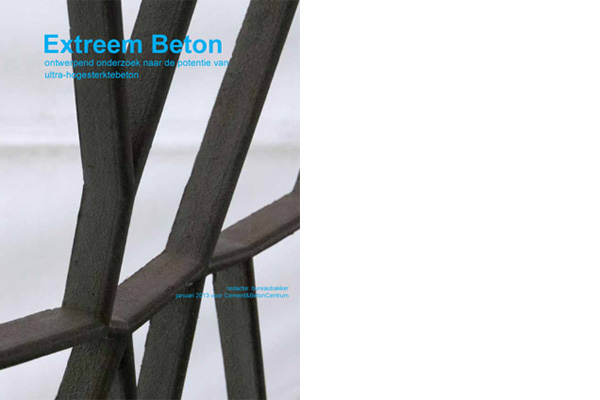
extreem beton
2013 / Dutch
Documentation on Ultra High Performance Concrete Casestudies. Design research on real-life potential of UHPC with multidisciplinary teams (design, engineering, production & client). Three teams explored possibilities on form, finance, sustainability and performance.
With ABT, De la Rive Box Design Engineering, G.tecz, Haitsma Beton, Hurks Prefabbeton, Natuurmonumenten, NIO architects, Pieters Bouwtechniek, Romein Beton, RoyalHaskoning DHV, UNStudio
editor & graphic design
Siebe Bakker
Backflap (NL)
Ultra-hogesterktebeton is meer dan een verbetering van het gebruikelijke beton. Er zit een nieuwe technologie achter, zowel wat betreft grondstoffen als procestechniek. Voor de noodzakelijke investering bij producenten is er behoefte aan marktvooruitzichten.Opdrachtgevers hebben behoefte aan aantoonbare meerwaarde, op basis van
succesvolle realisaties.
Het idee achter de UHSB-casestudies van het Cement&BetonCentrum is dat die aantoonbare meerwaarde slechts kan worden gevonden in een integraal ontwerpproces. De voordelen van UHSB liggen niet alleen op het terrein van vormvrijheid, ook op het gebied van onderhoudsvrije levensduur, gebruiksgemak en duurzaamheid. Door een
gezamenlijke inspanning van architect, constructeur, producent en bouwer, gericht op een realistische bouwopgave, moeten die voordelen aantoonbaar worden gemaakt en afgewogen tegen de bouwkosten.
Hans Köhne, Cement&BetonCentrum

concrete design book on energy
2012 / English
Documentation on Concrete Design Competition on Energy and workshop for laureates. Contains nominated entries, national jury reports and picture documentary of workshop.
editor & graphic design
Siebe Bakker
photography:
Bram Rutten
Backflap (EN)
The 5th Concrete Design Competition - ENERGY took place in 2011 and 2012. It asked students to explore and exploit notions on ENERGY in relation to the material concrete and architecture. Developed ideas were to be tested and presented through architectural design proposals, which could range from details and furniture to large buildings and technical systems.
The competition resulted in over 100 entries from more than 150 students. The topics of investigation varied from ingenious proposals of how to manage thermal concrete mass activation, to water-purification-systems and energy storage or energy harvesting building envelopes. Besides the ‘technical’ approaches many participants favoured to explore more poetic or ephemeral notions on ENERGY.
The national winners of the competition were invited to participate in a week long workshop, hosted by the Cement&BetonCentrum in the Netherlands. Facilitated by a staff of various experts, lecturers and critics and provided with ample working spaces, tools and materials, the students continued their architectural investigation into ENERGY and concrete. They were asked to redesign the facade system of the office building where the workshop was located. A true 70’s facade with a nowadays unusual depth of 90 cm. The students had to embrace and activate this depth, being able to either exploit architectural expression, offer new functionality, or both.
Working mostly in scale models, the ideas had to be developed through series of concrete models. Early on during the week one of the proposals was chosen to be produced on site in scale 1:1. A true learning experience unveiling some of the specific challenges occurring when building for real.
The workshop program saw a range of lectures on cement and concrete as well as two keynote lectures by architect / artist Daan Roosegaarde and architect Kapser Jørgensen, director of GXN. Especially the scale 1:1 prototype was made possible through the added support of Beamix, De Bonth van Hulten, Cugla, ENCI, Mebin and NOE Betonvormgeving.
The Concrete Design Competition is an initiative by Cement&BetonCentrum (NL), Cement Manufacturers Ireland (IE), FEBELCEM (BE), TCMA (TR) and VDZ (DE). Their aim is to stimulate innovative design attitudes related to concrete. They recognise that the use of concrete as an architectural medium shows room for improvements and development. The material is more than a tool to ‘solve’ formal design ambitions. Material research and understanding will lead to innovative design and create possibilities to surpass existing limitations and visions.
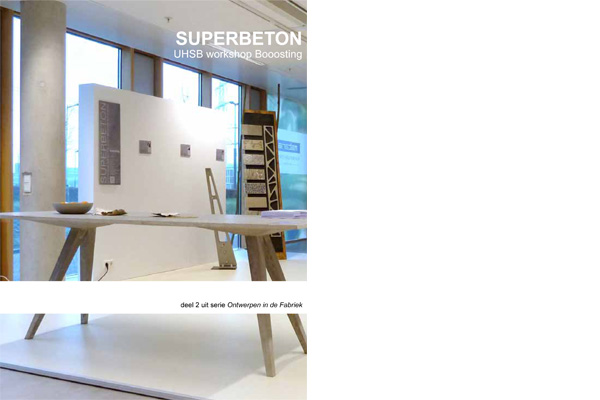
Superbeton
2012 / Dutch
Documentation on UHPC casestudy for Booosting members at Romein Beton. Participants explored the potential of Ultra High Performance Concrete and developed their own formwork. Romein Beton assisted with producing the prototypes.
editor & graphic design
Siebe Bakker
Introductie (NL)
Regelmatig bedenken architecten nieuwe oplossingen voor hun projecten. Helaas is de projecttijd vaak te kort om de nieuwe vondst uit te werken. Door perikelen met normeren, ontwikkelen en produceren blijkt de projecttijd te krap. En is het gebouw eenmaal opgeleverd, dan verdwijnt het idee in het archief. De focus ontbreekt bij architecten om de plannen verder uit te werken, de aandacht verschuift naar het volgende project. En dat is jammer omdat hierdoor
veel goede ideeën sneuvelen die het waard zijn uitgewerkt te worden.
Bij discussies in Booosting constateerden we regelmatig dit dilemma. Verschillende bureaus bedachten een eigen oplossing. Bij Atelier Pro, zo vertelde Hans Kalkhoven (nu studio Leon Thier), hadden ze er zo genoeg van dat de ontwerpers in het bureau telkens weer opnieuw trachten een ‘eigen, unieke’ balustrade te ontwikkelen, dat ze tezamen met Versteeg hekwerken enkele eigen ontwerpen ontwikkelden. En bij Mei architecten en stedenbouwers vormde Robert Winkel een ontwerpgroep die gesneuvelde projectideeën verder uitwerkte.
Wat uit deze voorbeelden blijkt, en niet alleen uit deze twee voorbeelden, is dat samenwerking met fabrikanten cruciaal is. Fabrikanten weten alles van hun materiaal en hun productieproces en kunnen architecten helpen de ideeën sneller te concretiseren. Tegelijkertijd leveren de ontwerpers de fabrikanten verrassende invalshoeken voor nieuwe producten.
Deze constatering leidde bij Booosting tot de serie Ontwerpen in de Fabriek. Fabrikanten, architecten en industrieel ontwerpers werken in de fabriek samen aan het realiseren van nieuwe oplossingen. In 2009 was de eerste sessie bij PP gevelbouw. De vele mogelijkheden van het gietproces en de vrije vorm mogelijkheden inspireerden de ontwerpers tot nieuwe vondsten in vorm, kleur en materiaalmelanges.
Dit jaar bood het Cement&BetonCentrum de ontwerpers ongekende uitdagingen met het Ultra Hoge Sterkte Beton (UHSB). Het is een betrekkelijk nieuw materiaal waarvan de ontwerpmogelijkheden nog lang niet uitputtend verkend zijn. In de fabriek van Romein Beton is een divers gezelschap ontwerpers de uitdaging aangegaan nieuwe toepassingen te bedenken met dit materiaal.
Frido van Nieuwamerongen
Arconiko architecten en Booosting
Inititiatiefnemer Ontwerpen in de Fabriek
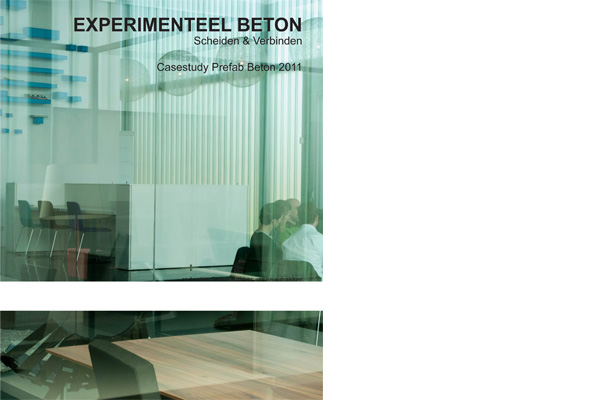
experimenteel beton - scheiden & verbinden
2011 / Dutch
Documentation on Prefab Concrete Casestudy 8 - Connect & Divide. Teams of designers and producers developed ideas and prototypes one of the elementary characteristics of prefab concrete elements: the seam.
editor & graphic design
Siebe Bakker
Introductie (NL)
Onderzoek naar de architectonische potentie van ‘de voeg’
Bouwen met prefab is bouwen met elementen. Inherent aan prefab is een beperking aan de elementgrootte. Dat leidt per definitie tot aansluitingen. Aansluitingen tussen de elementen onderling, aansluitingen op (draag)constructies en aansluitingen met andere bouwelementen als ramen, deuren, dakranden, goten, etcetera.
Veelal worden de ‘voegen’ tussen de elementen als storend ervaren in een gevelontwerp. Vreemd eigenlijk: immers buiten ‘in-situ-beton’ bestaat er eigenlijk geen naadloos bouwmateriaal voor gevels. De traditionele en nog steeds gewaardeerde baksteen is wellicht het kleinste prefab bouwelement dat voor gevels wordt gebruikt. In metselwerk zijn voegen vanzelfsprekend met een diversiteit aan tactiliteit middels verschillende voegtypologieën. En plaatmaterialen worden met vergelijkbare ontwerp- en uitvoerings overwegingen geconfronteerd als prefabbetonelementen.
Er zijn inmiddels verscheidene uitvoeringen toegepast waarin een uitgesproken architectonisch idee wordt nagestreefd. Variërend van ‘potdekselen’ en zogenaamde ‘valse’ voegen die de ‘echte’ voegen camoufleren, tot ‘kozijnloos’ glas in beton. Het werken in elementen biedt meer aanknopingspunten dan het ontkennen of maskeren van de aard van de bouwelementen. Er kan bewust gebruik worden gemaakt van het gegeven dat bijvoorbeeld een gevel is opgebouwd uit verschillende delen. Zo kan er uitdrukking worden gegeven aan de positie van de elementen
in het geheel (onder – boven, privé - publiek), of aan de functie die zich erachter bevindt. De grootte van de elementen kan uitdrukking geven aan massaliteit, menselijke maat of juist een monumentaal karakter ondersteunen. De ‘voegen’ zelf kunnen een architectonische uitdrukking bewerkstelligen. Daar waar er veel waardering is voor het uitbuiten van stortnaden, bekistingsplaten en centerpengaten, zoals bij onder andere Ando, Mendez de Rocha en Le Corbusier, is er nog weinig uitgesproken aandacht voor het exploiteren van ‘de voeg’. De
zone waar het element element wordt, waar eventueel techniek in opgenomen kan worden, waar slimme aansluitingen op draagconstructies hun plek kunnen vinden. Waar diepte gevonden kan worden in veelal vlakke gevels. En waar het ene materiaal een ander treft.
De casestudy ‘scheiden en verbinden’ onderzoekt wat de potentie is van ‘de voeg’. Wat architectonische, constructieve en uitvoerings consequenties zijn van scheiden en verbinden. Hoe technische innovaties hier een plek kunnen vinden. Hoe uitvoeringstechnische overwegingen een inspirerende rol kunnen spelen. En hoe architectonische ambities kunnen worden uitgebreid en ondersteund door het ontwikkelen van een tot nu toe onderbelicht fenomeen.
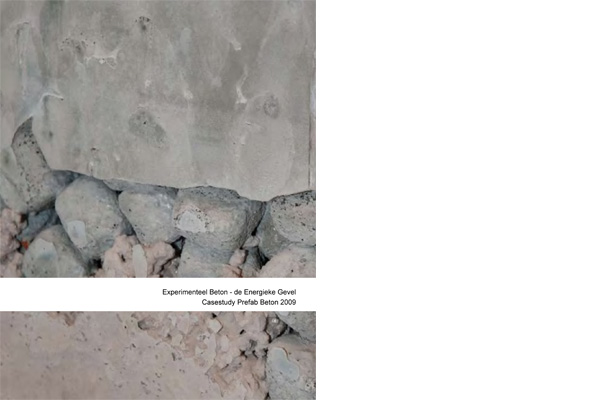
Experimenteel Beton - De Energieke Gevel
2010 / Dutch
Documentation on Prefab Concrete Casestudy 7 - The Energetic Facade. Exploring various notions on energetic in relation to prefab concrete facade elements, from energy producing structures to lively building systems.
editor & graphic design
Siebe Bakker
Introductie (NL)
Binnen de architectuur wordt de gevel traditioneel voornamelijk gezien als ‘de derde huid’ van de gebruiker. Zij toont het gebouw en haar programma aan de omgeving. De gevel beschermt tegen weersinvloeden en ongewenste bemoeienis van buitenstaanders. Het is de plek waar binnen en buiten met elkaar communiceren middels ramen, entrees, vorm en kleur.
De energieke gevel biedt meer dan een beschermende huid en een representatief beeld. Buiten het veld van de bekende passieve bouwfysische eigenschappen als thermische isolatie, zonen geluidswering speelt zij een actieve, dynamische en wellicht bewegende rol in het tonen of verhullen van verouderingsprocessen, de beheersing van de energie- en klimaathuishouding, het programma en de uitstraling van het gebouw en de interacties met gebruiker en omgeving.
De 7de Prefab Beton Casestudy richt zich op de mogelijkheden van beton voor een scala aan energieke gevelconcepten. Deelnemers wordt gevraagd hun fascinaties en ideeën in teamverband met specialisten te vertalen naar sprekende prototypen.
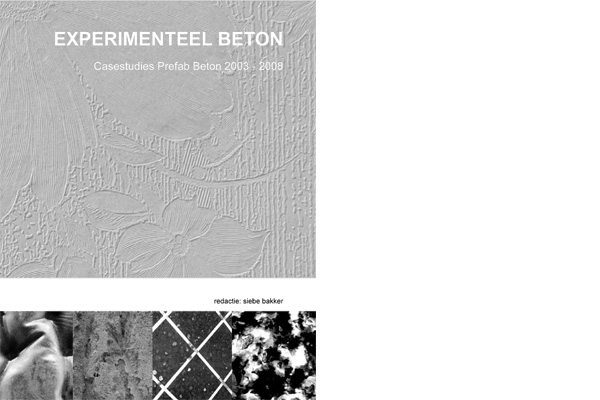
Experimenteel Beton - Casestudies Prefab Beton 2003 - 2008
2009 / Dutch
Documentation on the first six Prefab Concrete Casestudies. On the occasion of winning the Dutch Building Award 2009 for the Prefab Concrete Casestudy initiative and format.
editor & graphic design
Siebe Bakker
Jury Report Dutch Building Awards 2009 (NL)
'Creatief met beton! Zo omschrijft de jury deze inzending. En terecht. Uit de Casestudies Prefab Beton blijkt de potentie van dit bouwmateriaal.
Kennisuitwisseling tussen ontwerpers en producenten bewijst dat beton veel meer dan hard, grijs en rechttoe rechtaan is. De casestudies geven verbeelding de ruimte en leiden tot een vormentaal die de sector in
de regel niet kan of wil spreken. Deze ruimte voor creativiteit is goed voor het imago van de hele industrie. De integrale manier waarop het Cement&BetonCentrum de open dialoog en kennisuitwisseling aanpakt, is volgens de jury uniek.'
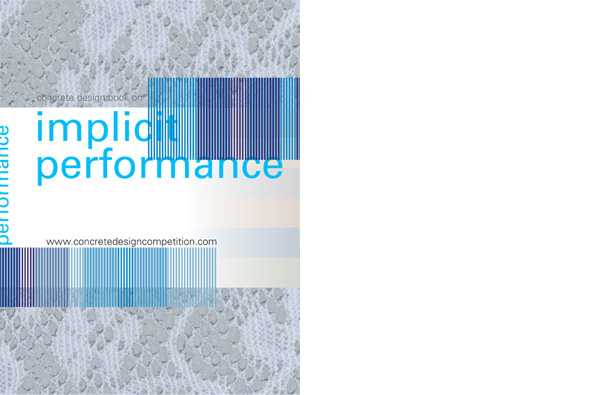
Concrete Design Book Implicit Performance
2008 / English
Documentation on Concrete Design Competition Implicit Performance and Master Class for laureates, curated by Juan Herreros. Includes all nominated competition entries and photographic documentary of master class. Texts by Juan Herreors, Jef Apers and Siebe Bakker. Interviews with René Boomkens, Michael Braungart, Ben van Berkel, Klaus Bollinger, Manfred Grohman and Olafur Eliasson by Eric Frijters & Olv Klijn. Interview with Juan Herreros by Stefan Devoldere.
editor
Siebe Bakker
photography: Brigitt & Charlotte Alberts
graphic design: Manifesta
Backflap (EN)
'the objective of the competition: to explore and exploit the limits of the involvement of concrete with other recourses to create new construction materials and applications where concrete forms the basis but is not the only element at play. It is therefore a question of finding conditions of comparability and integration - we could say a "complicity" - between concrete and something else in order to create a new material or system that adopts other characteristics.
We look for concrete surpassing its "original" performance to the point of becoming a new material in and of its self with contemporary spatial and experiential consequences. Behind the collective work that the competition evokes, there is an interest of generating practical implementations of theoretical topics on architecture as the construction of a second nature or second life. Creating architectural applications and systems for a world that needs to seriously reconsider the material conditions with which construction and demolition takes place.
Juan Herreros, curator
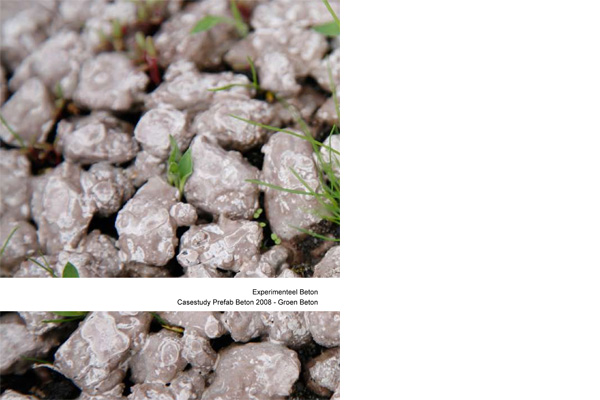
experimenteel beton - Groen beton
2008 / Dutch
Documentation on the 6th Prefab Concrete Casestudy.
editor & graphic design
Siebe Bakker
Introductie (NL)
Beton in de architectuur is voornamelijk bekend om enerzijds zijn constructieve eigenschappen en anderzijds om zijn soms bejubelde en vaak verguisde esthetische kwaliteiten. Op beide fronten vinden er ontwikkelingen plaats die voorlopig nog onopgemerkt blijven bij het grote publiek, maar door gedreven ontwerpers en bouwers worden opgepakt. De algemene tendens toont een verdergaande integratie van architectuur, constructie en installaties: beton als integraal en integrerend materiaal. De Casestudies Prefab Beton zijn bedoeld om recente ontwikkelingen te verkennen en nieuwe te stimuleren. In open dialoog tussen ontwerpers en producenten worden nieuwe mogelijkheden verkend en getoetst.
Voorgaande casestudies waren onder andere gericht op licht en beton, de mogelijkheden van vormvrijheid en verscheidenheid, verschillende vormen van ‘levend’ beton en de wens om het verouderingsproces van beton te controleren. Deze zesde casestudy richt zich op ‘groen beton’, een notie die onder andere de twee laatst genoemde thema’s in zich herbergt.
In een tijdsperk waarin begrippen als ‘duurzaamheid’ en ‘CO2- en klimaatneutraal’ op grote schaal naar voren worden gebracht als beslissende factoren voor onze toekomst is het destemeer zaak om genuanceerde, afgewogen en intelligente oplossingen en toepassingen te ontwikkelen.
Het ligt voor de hand om de duurzaamheid en de levensduurcyclus van beton te benadrukken en verder uit te buiten. Een betonnen skelet kan letterlijk eeuwen mee mits er voldoende flexibiliteit is ingebouwd voor uiteenlopende gebruiksprogramma’s die zelf een veel kortere levensduurcyclus blijken te hebben. Actief en passief gebruik van de thermische massa van beton zal een grote rol gaan spelen in het drastisch reduceren van energiegebruik in gebouwen. Daarnaast zijn er interessante vorderingen op het gebied van thermisch isolerend constructief beton.
Voorts blijkt er een latente vraag te bestaan bij ontwerpers en gebruikers naar een ‘echt’ groen beton: beton waarvan het levenloze karakter wordt gecombineerd met begroeiing, al dan niet in de vorm van mossen of planten. Een zoektocht dus naar ‘levende’ gebouwen of minstens gebouwen die een zekere vorm van natuur herbergen in hun architectonische en constructieve opbouw en dan niet slechts middels atria, binnentuinen of fantastische situering. De lange levensduur van beton roept ook op tot verbetering en beheersing van veroudering en verwering. Zo wordt er gewerkt aan zelfreinigend beton, wat de ‘originele’ verschijningsvorm benadrukt, terwijl er ook aandacht nodig is voor verouderingsprocessen die wellicht meer verschijnen als een metamorfose.
Kortom, daar waar ‘groen beton’ op het eerste gezicht een eenvoudige reactie lijkt op de vraag naar eco-producten strekt deze casestudy zich verder uit naar wellicht complementaire toepassingen.
Als laatste voorbeeld van aandacht is ‘groen beton’ ook op te vatten als reactie op de zoektocht naar perfect duurzaam wit of zwart beton. Beide zijn zeker nog niet ‘opgelost’; het perfecte groen staat zeker garant voor een gelijkwaardige uitdaging.
Aan ontwerpers hiermee de vraag zich te buigen over groen en beton, over persoonlijke fascinaties en drijfveren, die niet beperkt hoeven te blijven door de bovengenoemde voorbeelden en richtingen.
In de casestudy worden gezamenlijk de grenzen opgezocht van materiaalsamenstellingen, productieprocessen, toepassingen en gebruik.
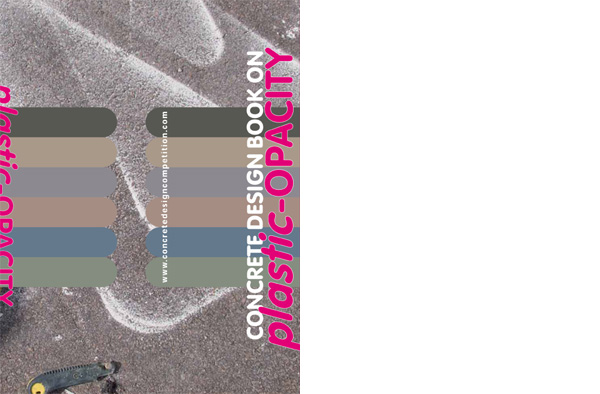
concrete design book plastic-opacity
2006 / English
Documentation the Concrete Design Competition on plastic-OPACITY and master class for laureates, led by curator Hanif Kara. Including nominees competition, jury reports and photo documentary master class. With texts by Hanif Kara and Siebe Bakker. Interviews with Hanif Kara, Ciro Najle, Bjarke Ingels, Akihisa Hirata, Harry Gugger, Joop Paul and Christian Schittich by Olv Klijn.
editor
Siebe Bakker
photography: Laszlo Csutoras & Melissa Liando
graphic design: Manifesta
Backflap (EN)
'Concrete is actually a very old material. The romans even used it. But it's still contemporary. recent developments concerning the strength, weight an durability are prompting innovative applications of this material. One property of concrete that has hardly been studied is its transparency. Transparency not in the literal sense of a property possessed by glass for example, but transparency in the spatial sense: opacity.
Apart from the historical reason to reconsider concrete opacity, there are more contemporary issues such as insulation and sustainability to be introduced, parameters that are reopening the chapter in ;opacity' with contemporary architecture. In most cases this is achieved by working with various types of glass and metal, but I think it should also be possible by using concrete.
Combining such a notion of opacity with the inherent plastic character of concrete could lead to an interesting play in which spatial definitions such as dimensions, depth and orientation could be linked to material properties such as weight, color and texture.'
Hanif Kara, curator
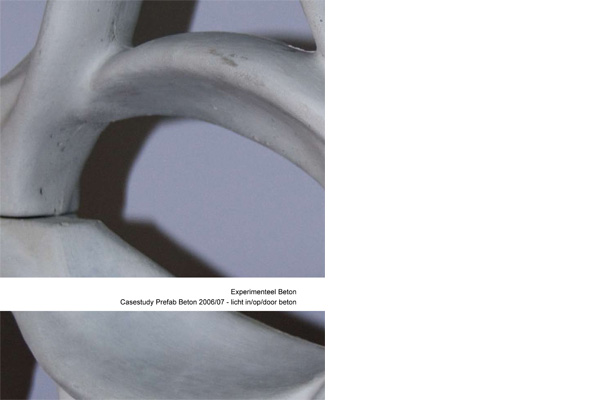
experimenteel beton - licht in/op/door beton
2006 / Dutch
Documentation on the 5th Prefab Concrete Casestudy. Driven by the passion to explore light and concrete various innovative combinations where developed and tested in prototypes.
editor & graphic design
Siebe Bakker
Introductie (NL)
Schoon beton (architectonisch beton) wordt voornamelijk ingezet en beoordeeld op haar visuele kwaliteiten, al dan niet in combinatie met de tactiele verschijningsvorm. En hoewel aan de geschiedenis van beton in architectuur een belangrijke constructieve ontwikkeling ten grondslag ligt laat zij zich ook lezen als gedreven door esthetische ambities. Zeker in het geval van schoon beton.
Het ‘beton brute’ uit de eerste helft van de 20ste eeuw toont het robuuste karakter van het materiaal, vaak met een ogenschijnlijke overdaad . Dikwijls zijn daarbij bekistingtechnieken ingezet die de plastische kwaliteiten van het materiaal benutten, vooral om door lichtval en schaduwwerking de vormtaal te ondersteunen. Meer als applicatie - een constructieve uitbuiting - kennen we allemaal de ‘bris soleils’ en ‘diepe gaten’ van Le Corbusier en anderen. Zo ontstond een helder en niet-beschaamd gebruik van beton, een traditie die navolging heeft gevonden bij onder andere een generatie Zwitserse architecten als Consoni, Morger & Degelo en Peter Märkli.
Op een meer subtiel niveau hebben architecten als Ando, Gigon & Guyer, Arets en Neutelings beton onderzocht op het tonen van ‘zachtheid’ en oppervlakbehandelingen. Niet zelden door het inzetten van strijklicht-condities door middel van zowel natuurlijke lichtinval als kunstlicht.
De meest recente ontwikkeling van het combineren van beton en licht laten een meer radicale zoektocht zien naar ‘echte’ transparantie van het materiaal zelf. Daarbij wordt geëxperimenteerd met glasvezel-technieken en het vervangen van toeslagmaterialen door glas of kunststoffen.
Denk aan LitraCon en Bill Price’s ‘translucent concrete’. Daarnaast komen er steeds meer producten die naast een bouwkundige functie een ‘verlichtende’ applicatie herbergen, zoals op gebied van signalering, bewegwijzering en decoratie.
Deze Casesstudy geeft ruimte voor onderzoek naar combinaties die de prestaties van licht en beton vernieuwen, maximaliseren en uitbuiten. Van ‘low-tech’ bekistingtechnieken, oppervlakafwerkingen en bouwkundige of esthetische ‘add-ons’, tot ‘high-tech’ toepassingen die ontwikkelingen uit andere industrieën koppelt aan – nieuw te ontwikkelen – productieprocessen voor prefab beton. Aan de ontwerpers de taak zichzelf en de industrie uit te dagen om de grenzen van het materiaal te zoeken. Aan de industrie de taak de bestaande grenzen te overschrijden en de denkprocessen te toetsen aan de nieuwe realiteit.
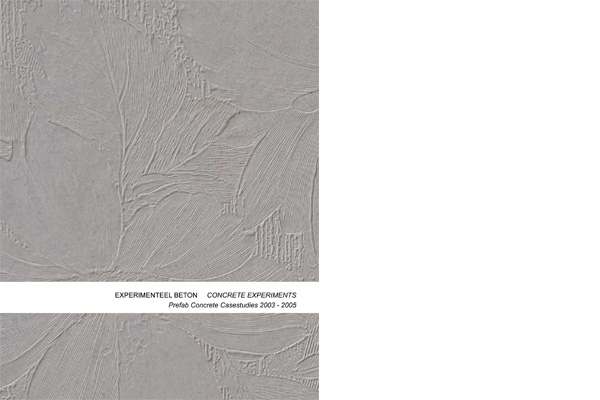
concrete experiments - perfab concrete casestudies 2003 - 2005
2005 / English/Dutch
Documentation on the first four Prefab Concrete Casestudies.
editor & graphic design
Siebe Bakker
What you always wanted to do in concrete... (EN)
Always wanted to know how to control corrosion of surfaces? And how to keep them aesthetical intriguing? Are there samples in architecture or art that keep puzzling you in terms of how they were created? Want to know if it is possible to generate formal or tactile ‘chance’ within a serial production method? Want to understand and manipulate existing production techniques and methods to push the envelope of the possible? Just having an outrageous idea? That you like to get tested for practical and economical feasibility?
Unanswered questions, extreme applications and seemingly impossible ideas form the starting point of these Casestudies. How to realise ever further reaching fascinations and ambitions of architects and designers is the core of this initiative.
These are Casestudies since ideas are not only examined and explored with professional support, they are actually manufactured in order to really test their merits. Specialists from various producing industries as well as engineers and research experts have worked in one-day intense brainstorm sessions in which proposals have been developed into effective descriptions for generating the prototypes. The collaborating industry have manufactured these objects under professional conditions in order to be analysed and reviewed.
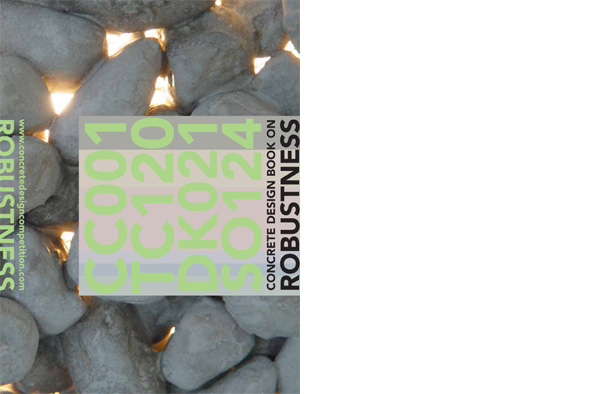
Concrete Design Book ROBUSTNESS
2004 / English
Documentation on Concrete Design Competition ROBUSTNESS and master class for laureates, led by curator Michael Speaks. Includes all nominated entries, jury reports and photo documentary on master class. Tetxs by Michael Speaks, Siebe Bakker and Hans Köhne. Interviews with Karl Daubmann, Bernard Cache, Wim van den Bergh, Alejandro Zaera-Polo, Hanif Kara, Annette Gigon & Mike Guyer by Olv Klijn
editor
Siebe Bakker
graphic design: Manifesta
Backflap (EN)
'... there are qualities associated with ROBUSTNESS, such as strength and solidity, which are also qualities of concrete. Used to lay foundations, to build sturdy bridges and muscular, architectural monuments, concrete, even in its most conventional use, is an undeniably robust material. There are other qualities associated with ROBUSTNESS, however, not conventionally associated with the sturdiness of concrete. Due to the growing importance of complex, adaptive behavior in all areas of scientific equity, ROBUSTNESS has also come to define the degree to which living things, whether single cell organisms, flocks of migratory birds, or complex social systems like ant colonies or metropolises like Tokyo or Mexico City, adapt to changing environmental conditions and evolve over time. ROBUSTNESS, in these contexts, defines a new kind of strength and solidity based on flexibility rather than inflexibility, on suppleness rather than stiffness, on resilience rather than rigidity...'
Michael Speaks, curator